Once called “the Ritz Hotel of the Far East”,1 the Chosen Hotel was, for a time, the last word in luxury and comfort in Korea. Dignitaries, statesmen, royalty, celebrities, casual travelers, and locals graced its elegant spaces with their presence. Militaries occupied it as one would a barracks, and officers used it as their billet, but it somehow retained much of its prestige between then and Korea’s industrialization. The original building stood for only half a century, and while its legacy lives on, much of its colonial period history has not been made easily available to the public. This article seeks to explore and contextualize the architectural and social history of this once iconic building.
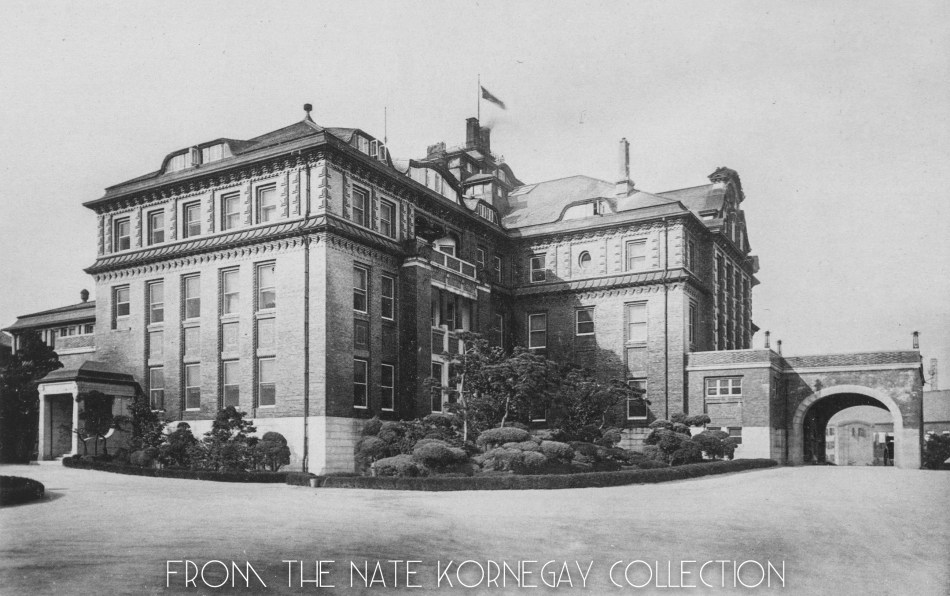
The Architect and Builders
It would be no exaggeration to say that the Chosen Hotel was a progressive structure, surpassing most, if not all, of the Western-built hotels in Japan at the time of its completion. Indeed, in 1922 one former journalist called it “a hotel that has only one superior in East Asia.”2 (It is unclear which hotel the author thought was better). At a glance, the careless eye would interpret its most prominent features as an indication of it being a wholly classical, if not antiquated, building. Yet in order to more fully understand the structure’s architecture, we must first look to those that designed and built it.
Around 1903, a just-over-thirty-year-old Georg Karl Adolph Guido de Lalande arrived in Yokohama to take over the architectural office of Ludwig Richard Seel.3 With only six years of working experience in Germany, and another two in China, de Lalande was somehow able to quickly make a name for himself as the head of Seel’s former Yokohama firm. De Lalande was exposed to the architectural world at an early age, having been born in a Prussian province to a father who worked as a building contractor.4 Once he made his way to Japan, de Lalande and the other architects in his Yokohama office designed numerous residences, company buildings, hotels, churches, schools, and even one consulate.
It was then the success of his Oriental Hotel, built in Kobe in 1907, that was likely a key deciding factor in his being commissioned for the design of the Chosen Hotel. Precisely when de Lalande began drafting plans for the Chosen Hotel is unclear, but we know that the structure’s groundbreaking commenced on March 15, 1913.5 According to one source, the construction of de Lalande’s design for the Chosen Hotel was carried out by Shimizu Co., a then private company that had a long history of involvement in national (Japan) projects during the 1800s.6 The Government-General was also involved in the project, specifically providing bricks and cement,7 if not also design input.
The Chosen Hotel opened in October of 1914, but de Lalande never got to see the completed hotel in operation. The forty-two year old Prussian architect visited Seoul on business two or three months prior to the opening, perhaps to see what had come of his design.9 There, de Lalande came down with a terrible case of pneumonia, resulting in his death on August 5th.
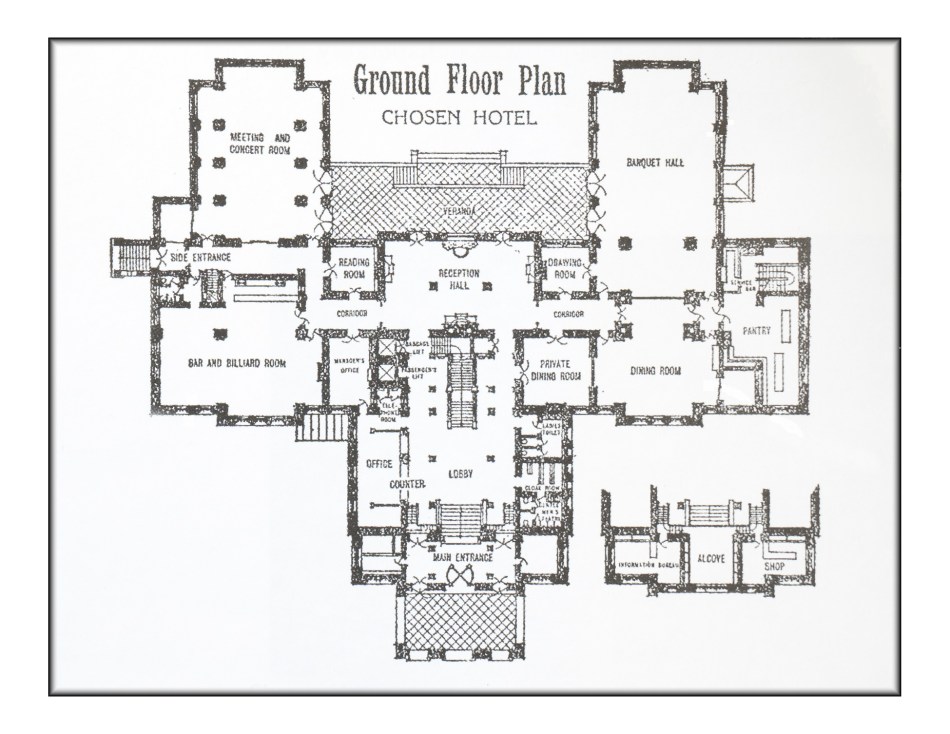
The Chosen Hotel’s Eclectic Exterior Design
Georg de Lalande’s plan for the hotel came during the height of German-Neorenaissance architecture in the Japanese world, having been popularized under the influence of foreign advisors since the 1890s. Indeed, other railway hotels such as Busan’s and Shinuiju’s, which were built just a few years before the Chosen Hotel, were done in this common, slightly Japanized, German-Neorenaissance style found throughout the empire. De Lalande abandoned many of the Classical architectural elements that had become normalized in Japanese-supported Western-styled buildings, but several key visual features of the Chosen Hotel were in fact made with strong Classical – specifically Baroque – influence.
For the entry facade, de Lalande might have called upon the designs that he grew up surrounded by in his hometown of present day Jelina Góra, a place whose main square is still filled with old architecture containing a similar facade design used for the Chosen Hotel. Comparable facade designs are found in Belgian and Dutch Baroque buildings, from the guild houses in Antwerp to the Upper Belvedere in Vienna and the Basilica of St. Ann in Altötting. The almost calligraphic central facade shape of the Chosen Hotel, with its rounded edges and scroll forms, is a core component of Baroque art and architecture, reminding us of the crest rails in Louis 16th style furniture and the curvy f-holes in violins.
This central section is the part that one’s eye is most drawn to, which confuses the average passerby into thinking that it is a sort of old world Baroque building. However, a closer look reveals that the Chosen Hotel was not just another “Neoclassical” building. It was modern in a way other buildings were not. The central facade makes us think “Baroque”, and something about the chimney also reminds us of densely packed old French row buildings as well, but it was a transitional structure caught between different architectural styles. Evoking the jugendstil trend in Germany, the hotel’s builders implemented some creative elements in accordance with Art Nouveau.
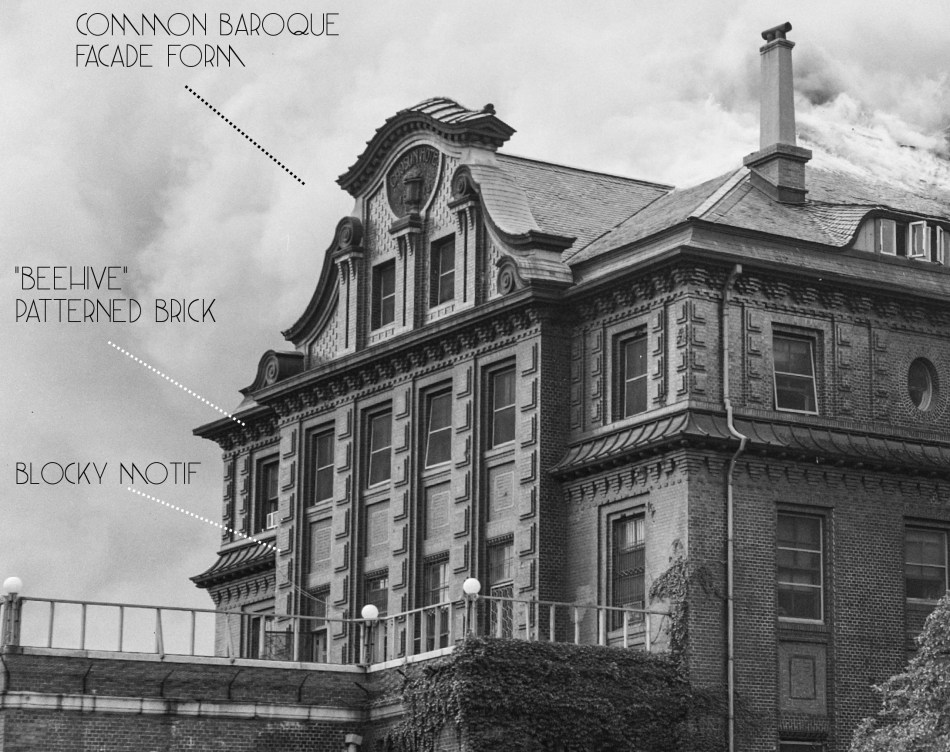
Firstly, the sculptural aspects of Baroque architecture were mostly abandoned in the making of the Chosen Hotel, instead mostly relying on brick to create motifs. Aside from the scroll work on the central Baroque facade, there was almost no purely classical ornamentation whatsoever. Rather, the hotel had artistically patterned (almost parametric) “beehive” brickwork just above the third floor, and pyramidal patterned brickwork just above the second floor. These were probably meant to replace the sculptural ornamentation found in typical Baroque and Renaissance buildings. (Use of brick in this same way can be found in 1900s-1910s Victorian-Neoclassical influenced brick structures in North America and the United Kingdom, where the exact same “beehive” and pyramidal patterns can be observed).
Creating blocky, geometric ornamentation instead of smooth, sculptural ornamentation, the hard lines of this brickwork are significant as they blur the lines between old and new styles. The brickwork alludes to Baroque ornamentation without actually being old Baroque ornamentation. Carrying on this blocky, geometric theme, rectangular motifs can be found throughout the structure’s facade. Even the columns in the second floor balconies featured little protruding block forms that mimicked the geometry in some of the brickwork.
The color of the brick, too, was significant. Instead of the common red-orange bricks and white stone found in Seoul’s many Neorenaissance buildings, the hotel’s bricks were made with a dark reddish-brown hue. The stylistic shift to brighter brown-yellow building color schemes within the Japanese Empire wouldn’t begin to take place for another decade, but the Chosen Hotel was already making a change away from the colors that were standard at the time. (We know that some tiles were imported for the Chosen Hotel from Germany and the United States,10 but it is unclear whether or not any of these were used on the exterior. They may have been interior tiles.) In this way, the hotel was a building truly caught between the emergence of modernism and old world European styles.
While it is easy to say all this in retrospect, with the opportunity to study what was being built before and after the hotel, it was unclear what direction various architectural movements would take at the time. Locals in Korea could not have known it, but the Chosen Hotel’s basic form was about ten years ahead of its time. There wouldn’t be another building like it on the peninsula in shape or form until about a decade later. To understand this, we must look at a simplified image of the structure – without its Baroque influenced roof.
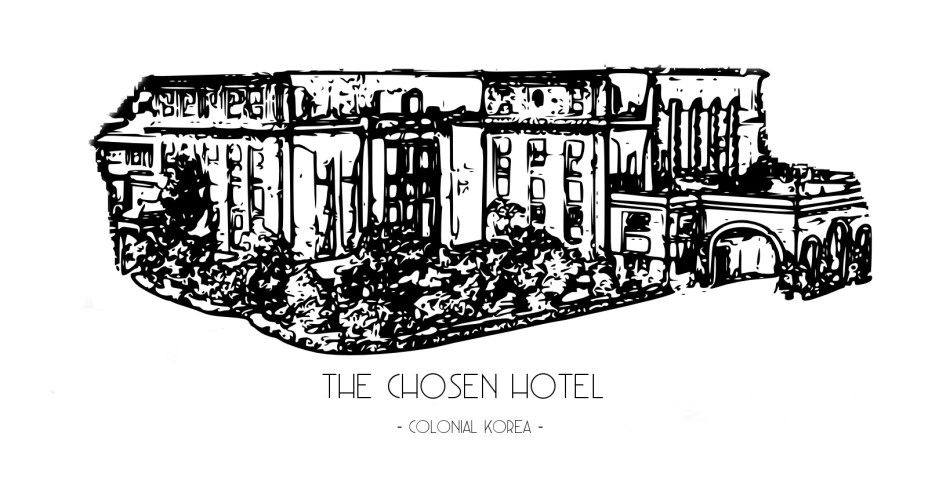
A rough, stylized image of the Chosen Hotel imagined without its roof. Source: This stylized image is derived and drastically altered from a photo taken by Seong Du-gyeong in the 1950s-1960s.
Without its Baroque and Art Nouveau roof, the Chosen Hotel arguably resembled any (Japanese) government administration building (in form) from the 1920s-1940s. Such government buildings generally followed a similar winged format centered on a car port (the car ports being a historically significant feature as it signaled change in architectural trends). Indeed, it is largely the roof design that makes the building Baroque at all. Had the hotel been built twenty years later with a flat roof, it still may have been able to pass as some kind of modernist structure. Furthermore, the strong division of the top floor facade from the rest of the building was unseen in Korea until Art Deco came into vogue in the 1920s and 1930s. While other architects were still using Neoclassical styles, de Lalande’s hotel may have been the first institutional building to break this mold in Korea. It might have even informed the design of the nearby Chosen Commercial Bank – a building that wouldn’t be built until a full decade later.
With this in mind, the roof and central facade can be said to have significant influence over how we read the structure, for it is these points that make the Chosen Hotel a transitional Neobaroque-Art Nouveau building, and not merely another “German Neorenaissance” building.11 Admittedly, its hip and gable slate12 roof is standard in Western architecture and its dormer windows clearly drew from Dutch-German Baroque examples in Europe. (See the dormer windows in the most recent reconstruction of Gutshaus Tützpatz, dating to 1908, for a good example of German Baroque architecture similar to the kind that de Lalande used. The exact same style of dormer was used in 1924 in the nearby Chosen Commercial Bank). However, unlike earlier examples in Germany, concavity and curvature was added to the Chosen Hotel’s roof. These concave lines in some of the hotel’s dormers gave the building an Art Nouveau flair. Similar curvatures are found throughout the roof work, particularly around the central chimney where a drooping verge is found on an almost karahafu-like gable.


A drooping verge, or minoko, is commonly featured in classical Japanese architecture, and the similar curves in the dormer windows perhaps further suggest Japanese workmanship. Below the third story windows, a decorative pent roof wraps around the entire building. This element is in a decidedly Asian fashion, mimicking the lines of a mokoshi roof in classical Japanese architecture (which is typically straight), but with all the dramatic concavity of a Korean giwa roof. These mokoshi lines are carried out over the hotel’s emblem, as well, in the very top-center section of the facade.
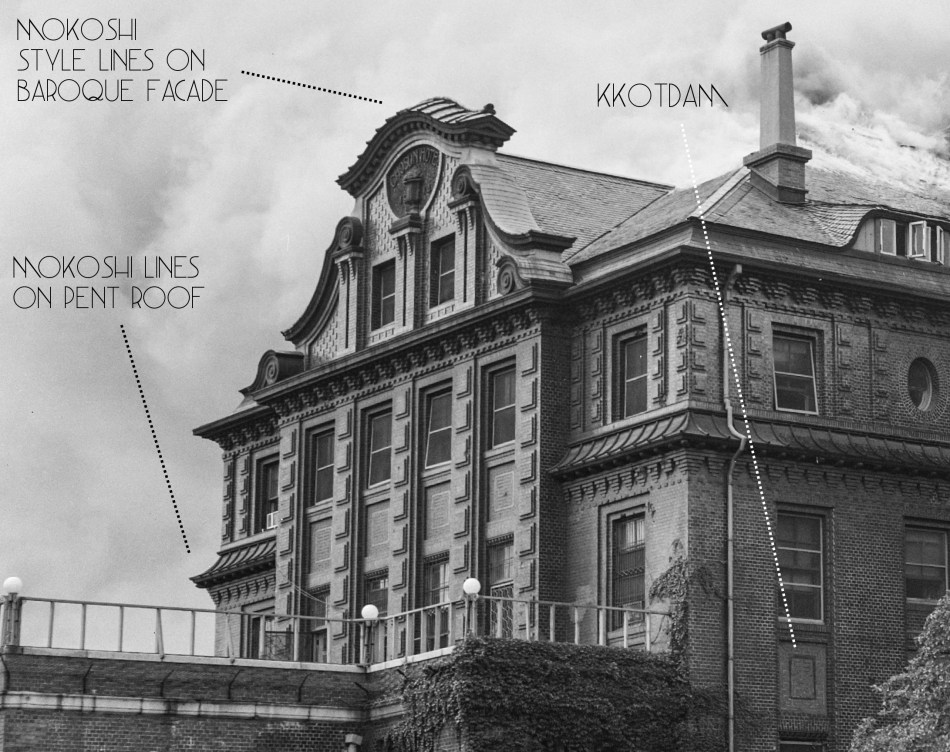
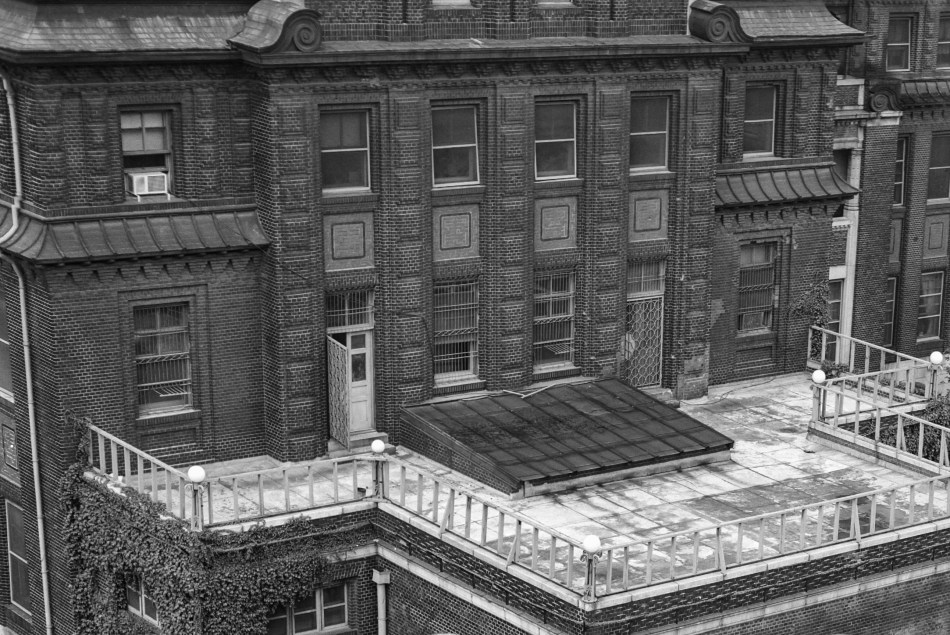
On further examination, more evidence of Asian architectural influence appears. In the third floor balconies, a patterned brick may suggest Chinese masonry, while the framing of the balconies’ porches arguably resemble the framing of royal Joseon audience halls. Decidedly uncolorful and undecorated, the form is similar to the timber and rafters of Gyeongbokgung’s various halls, for example.
More compelling evidence for the hotel having Asian architectural influence is in the patterned Korean brick designs, or kkotdam, found in the setbacks between the first and second floor windows. In a very clear homage to Korean architecture, these brick designs called upon the Joseon patterns found in the walls of palaces and stately hanok. They were probably copied from near-identical examples that can be found in Gyeongbokgung today. In the Chosen Hotel’s kkotdam, a repeating motif made up of the Korean character “ㄹ” dances around the Chinese character for longevity “壽”.13 The kkotdam‘s handsome black and red tile suggest Chinese mason work, as do the aforementioned “beehive” and pyramidal brick motifs (a very similar brick design appeared on the old Chinese Consulate in Chemulpo [Incheon]). On the rear facade, the kkotdam design is replaced by an unperforated Qing cross design. Lastly, the hotel grounds were surrounded by Joseon palace styled stone walls and entered into via a one story Joseon styled gate. (Click here for link to photo).

For all the criticism that colonial era buildings receive today, the Chosen Hotel was markedly mixed and represented architectural features from a number of cultures. It is unclear how much of a say de Lalande had over the final design, for large projects such as this one sometimes went through a number of drafts with strong input from the Japanese government. However, amidst all the blatantly authoritative, imperialistic styles being transplanted into Seoul, it is very interesting to see that the Chosen Hotel’s builders were actively trying to incorporate the local texture into a new hotel building with the knowledge that they were placing it on the former Korean ceremonial site, Wongudan.
Wongudan, in its most recent form, was built in 1897 around the time when the Great Han Empire was declared. This Joseon styled complex only stood for sixteen years, presumably demolished just before the Chosen Hotel’s groundbreaking in 1913. Yet, as many know today, not everything from Wongudan was lost. The Hwangungu, or “Tower of Heaven” as it has been called in English, was purposely incorporated into the grounds of the new hotel.


It is unclear who is to credit (or blame) for the use of Korean elements in the hotel, but evidence of Japanese government architects altering other Western building designs before their completion could suggest that the decision to use Korean architecture may have been made at the institutional level, and not by de Lalande. The New York Times reported in vague terms that the hotel was built by “Japanese authorities from a design by a German architect”,14 leaving plenty of room to question who exactly was involved in the hotel’s construction. To be sure, when we look at de Lalande’s other works, he almost always worked in Classical European styles. It’s possible he strayed when designing the Chosen Hotel – he certainly did to some degree as he edged into Art Nouveau for this building – but it is also possible that the ideas for the hotel’s mixed Asian influence came from Japanese draftsmen and advisors involved in the building’s construction. This theory could be further supported by the fact that the plans for another building that de Lalande was initially involved in were significantly altered by the Government-General’s architectural office before it was finally completed.15
To be sure, no other hotel at the time of the Chosen’s completion borrowed local native architecture in the way that this hotel did. Hotels within the empire’s holdings were then either Western or Japanese in style, so why did the builders choose to implement Korean architecture in this hotel’s design?16 Some could assume the usage of Korean architectural elements to be cultural appropriation, where Japanese builders purposely sought to sanitize Korean culture by superficially fusing it with their modern buildings. The same individuals could also view the placement of the hotel over Wongudan as a symbol of Japanese imperialism, while the opposing view would argue that the location was simply prime real estate. We could also interpret the hotel’s Korean influence as a manifestation of Japanese fascination with Koreana.17 An alternate reading with the tourist in mind would show these Korean elements, particularly Hwangungu, to be part of a tourism gimmick meant to capitalize on the perceived exoticism of Korea. Unfortunately, without knowing the builders’ intentions, the reasons for including Korean architecture in the building are likely to remain unclear.
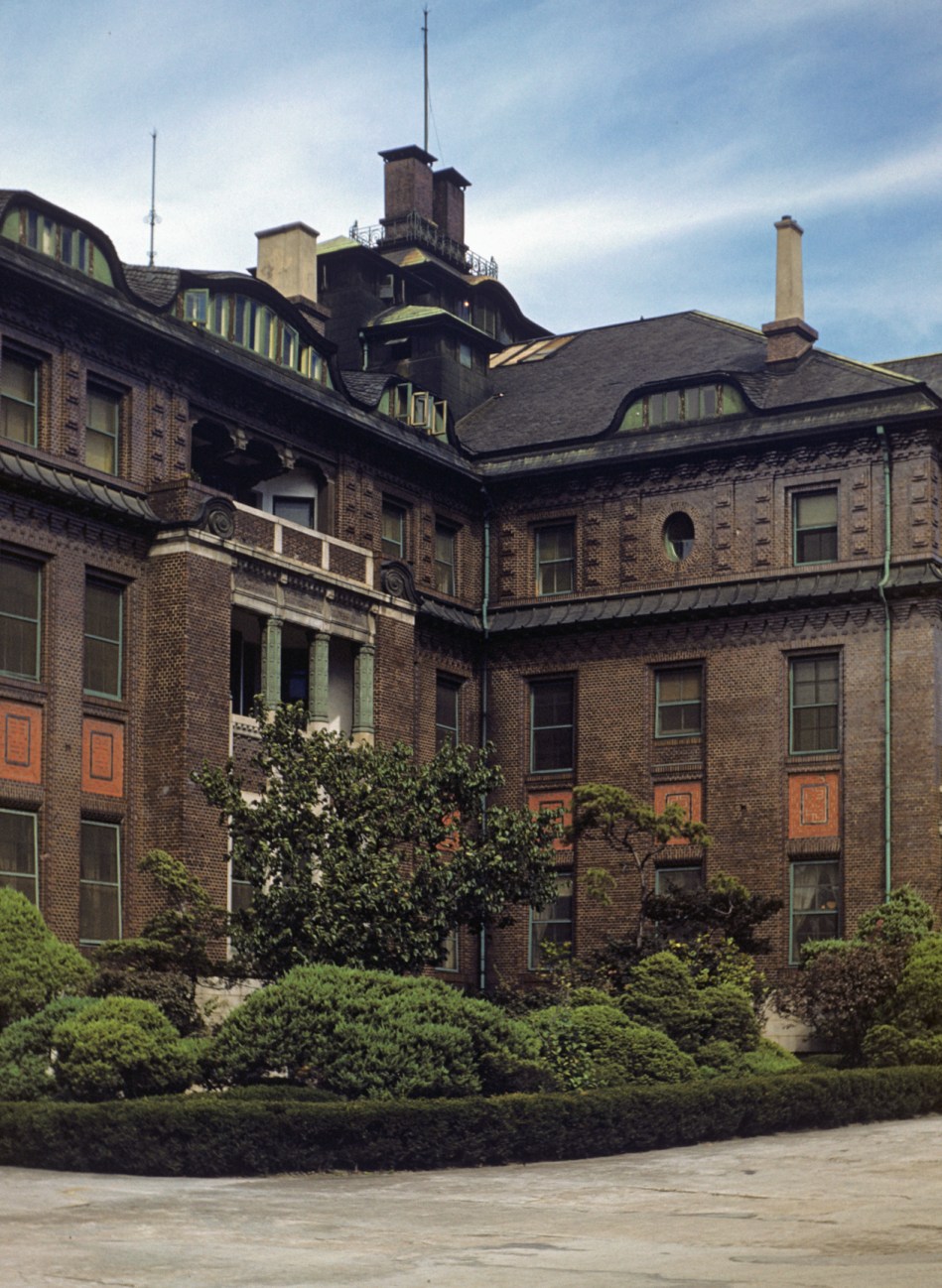
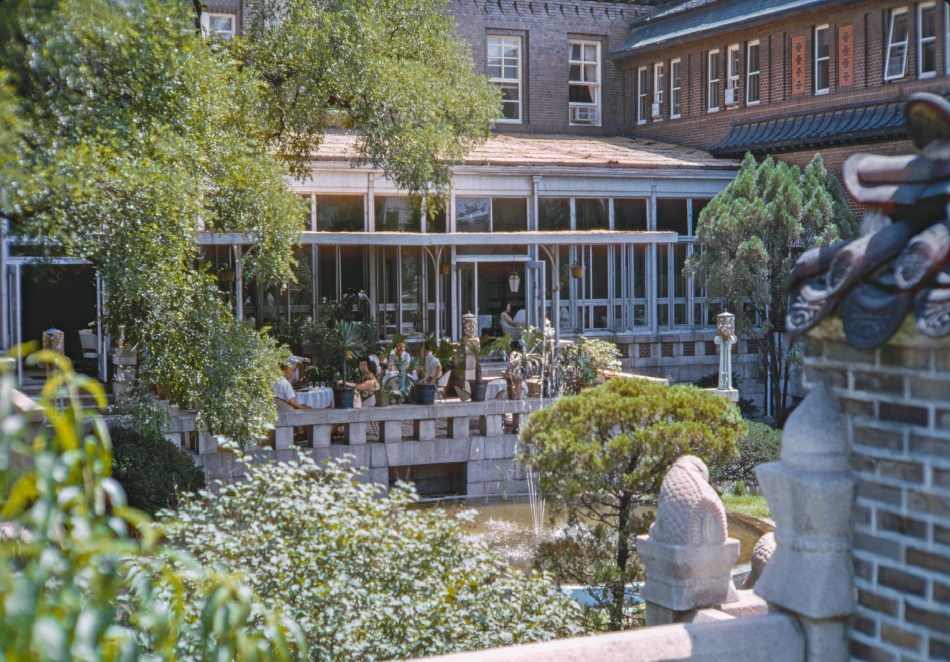

The Chosen Hotel’s Interior and Landscaping
Despite its eccentric exterior, the Chosen Hotel’s interior architecture, design, and furnishings were fairly typical of the time when it was completed. One book mentioned the drawing room’s Louis 16th style,18 possibly referring more to the furniture than anything else. However, the hotel’s decor went beyond Classical or Victorian European design. From the car port, a revolving door opened to a marble staircase which led into the main lobby, whose walls and columns were covered in square tiles of various shades – beyond trendy for the time. The Chosen Hotel may have been one of the first buildings in Seoul to feature this kind of tile work as it was around then that ceramics in the metropole were shifting away from Victorian painted graphics to textured, colored tiles. These columns were finished, at the corners, with even more impressive tile work: little ceramic pieces formed in the spiral shape of fabric passementerie or drapery which helped to round off the columns’ edges. Author and journalist Willard Price noted the hotel’s “deep rugs,” “pink and gold decor”, and “murals of idyllic Korean scenes done by a Japanese educated in Paris.”19 A mix of artistically shaped electric light sconces coincide with the Art Nouveau style.
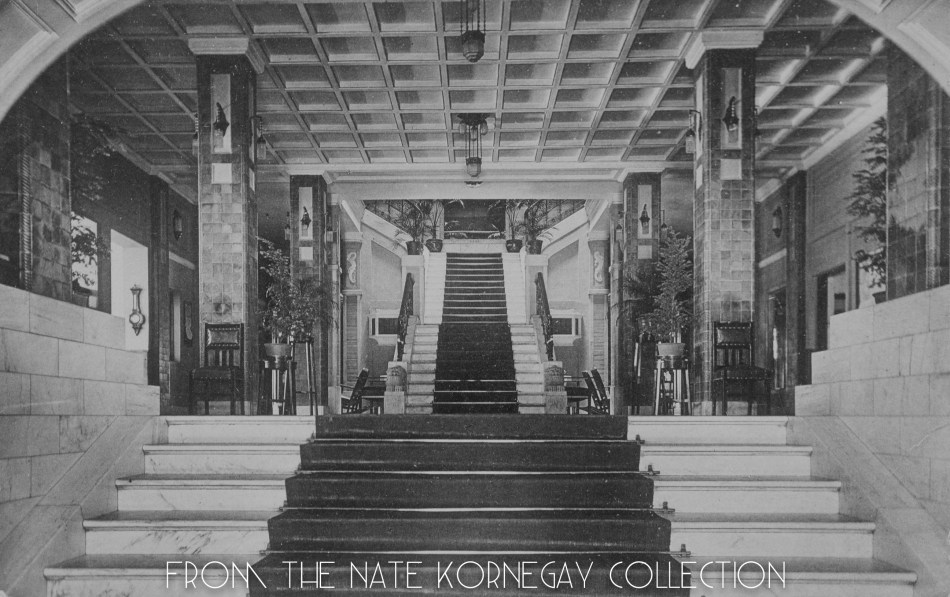
On the left, next to the check-in desk after one entered the lobby, were two imported Otis elevators,20 one labeled for visitors and one for luggage,21 which were probably finished in brass metalwork. The hotel’s interior might have even featured a Steinway piano at one point. 22 With its handsome wrought iron railing, the central staircase’s base was guarded by two ambiguously Asian styled “lion-dog” statues and a pair of molded seahorses looked on from columns of either side (pictured above). The statues may have been inspired by similar examples found in the stone fencing surrounding the Hwangungu “Temple of Heaven” itself, but were not exact copies. All of this was lit by a stunning crystal chandelier hung above the stairwell, imported from Tiffany & Co. in New York City.23 (Unfortunately not visible in the above photo.)
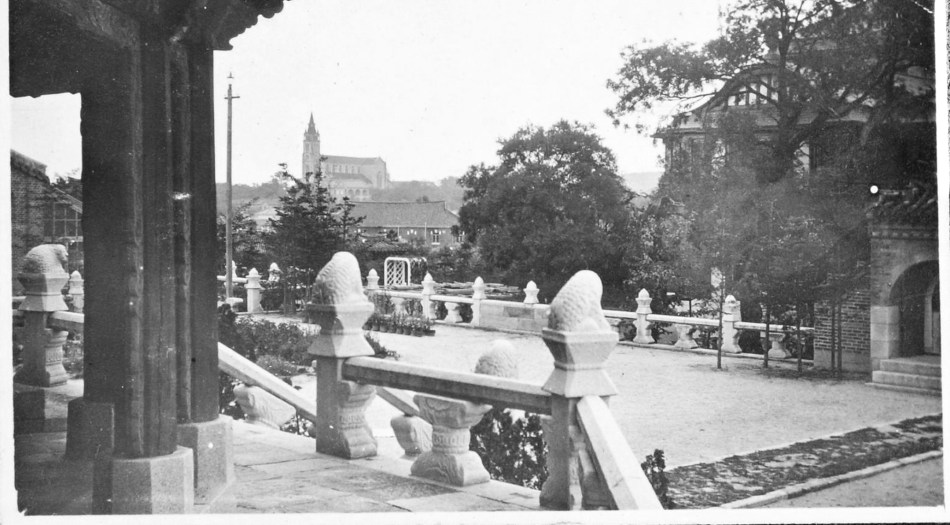
The decor, wares, and furnishings were of the kind that Westerners would expect to find in a foreign luxury hotel. The beds, blankets, linens, and utensils were all imported from various Western countries.24 Palm trees dotted the hotel’s public spaces while the sun room was occupied by wicker seating, exuding the kind of homogenous, international-exotic flair commonly found in Colonial Style interior design throughout luxury hotels in South America, Africa, and Asia. The Chosen Hotel reportedly contained a drawing room, public and private dining rooms, a concert room, a billiard room with English and American tables,25 and a large ball and banqueting room that hosted concerts and dances.26 A “finely appointed bar” and “delightful reading-room supplied with magazines and papers from all the world – except Korea” further catered to the internationally-minded, well to-do visitor.27
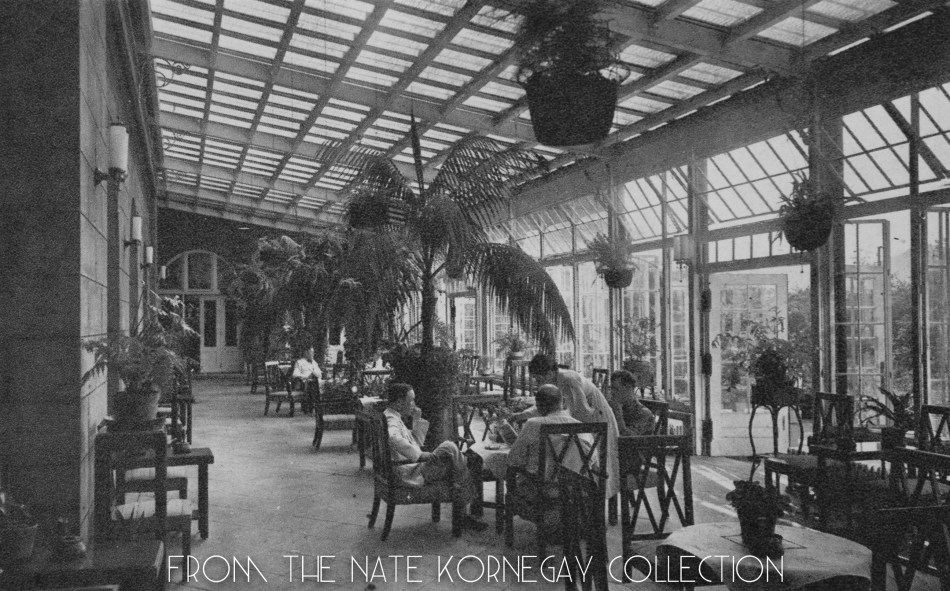

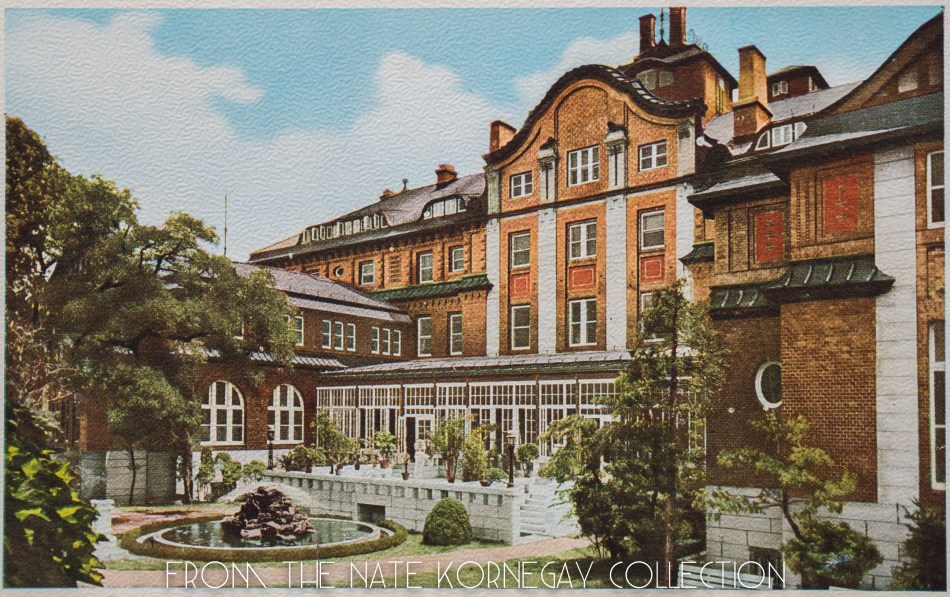
Conflicting sources from various periods suggest the hotel had around 60-80 guest rooms. This may mean that some rooms were repurposed for other uses over time, or that some rooms could have become semi-permanent residences. This was certainly true of room 201, which served the hotel’s most esteemed guests. These guest rooms, which each had their own private bath, were equipped with beds and bedding from the US, Germany, and France.28 The hotel was heated by modern boiler and radiator technology and the kitchen appears to have, at some point, been outfitted with a European stove-cooker in the AGA style.
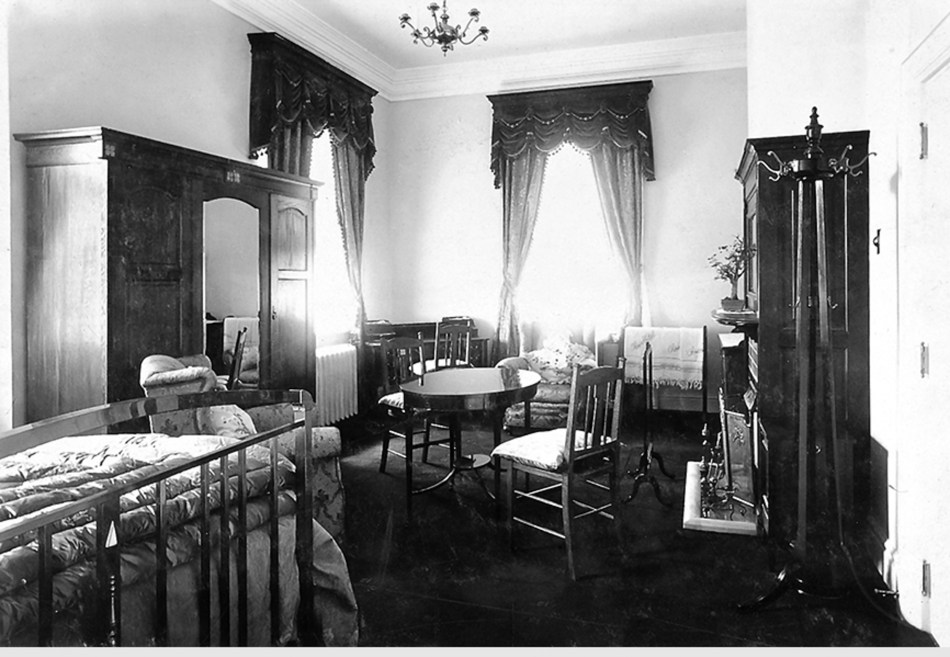

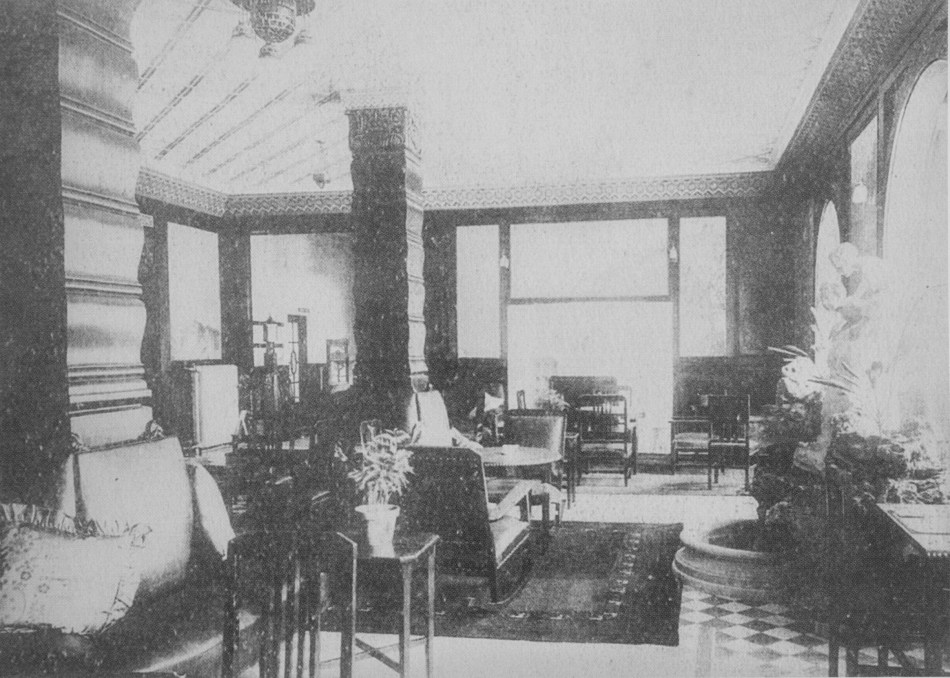
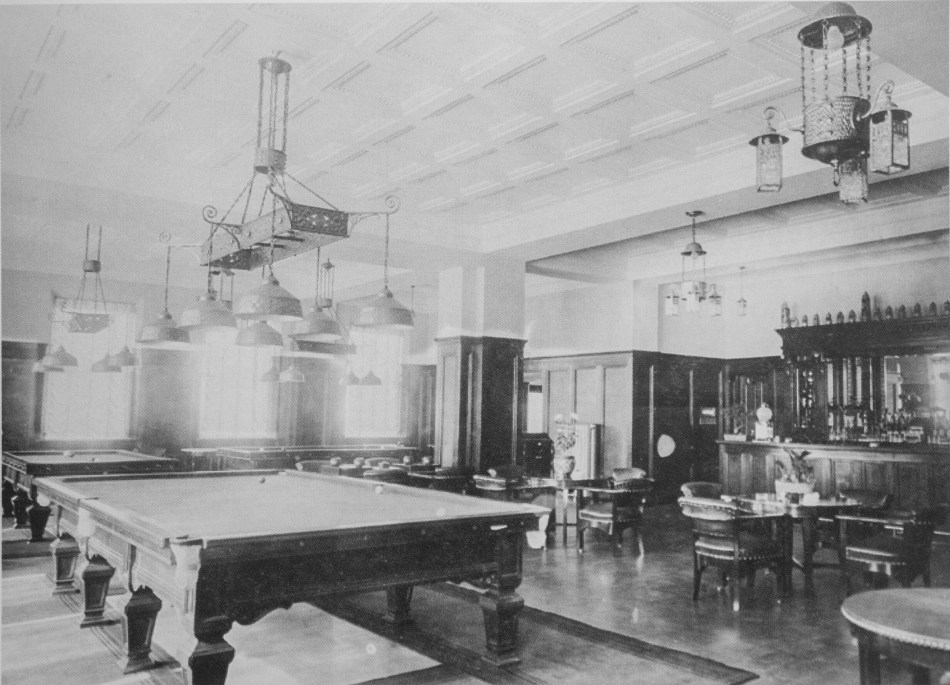
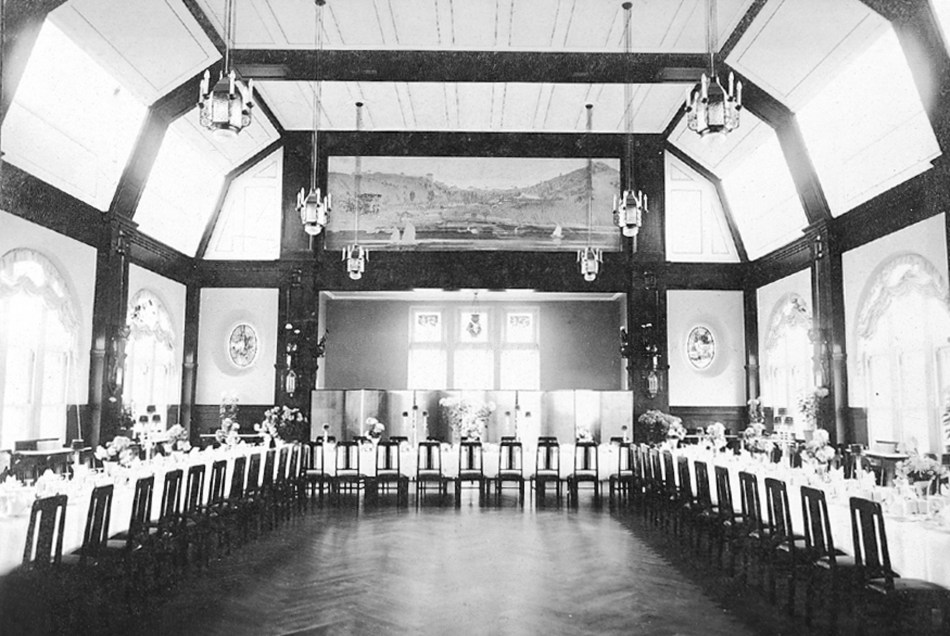
Outside, even the landscaping was well planned. The hotel’s famous garden, which was built over other parts of Wongudan,29 was supplied with red roses from the Belgian Consulate grounds when it closed during World War I.30 One former journalist romantically described the area as “a garden heavy with the fragrance of many roses. At night, when the paper lanterns on the terrace are reflected in the lotos pools, and the incense from the Temple of Heaven mingles with the perfume of the flowers, it is a place to be marked with a white mile-stone on the road of memory.” 31
The fountain was reportedly electric,32 and Hwangungu itself was uplit at night, too. In addition to the palm trees used to decorate the interior, which were certainly imported, the hotel grounds contained what are colloquially known in English as pink silk trees (albizia julibrissin). Native to some parts of Korea, this particular tree seems to have been specifically cultivated for use on the ground of the Chosen Hotel, having not been observed in the wild in the Seoul area around 1917.33 These trees, due to their pink and white stamens that arguably simulated the colors of cherry blossoms, may have been picked for their (Japanese language) association with sleepy summer evenings, ability to be trimmed in the bonsai fashion, and high tolerance to cold temperatures.34 Also found at the Chosen Hotel were “Japanese prickly ash” (fagara ailanthoides)35 and a particular “Asian” vine with red and yellow fruit (celastrus articulatus).36
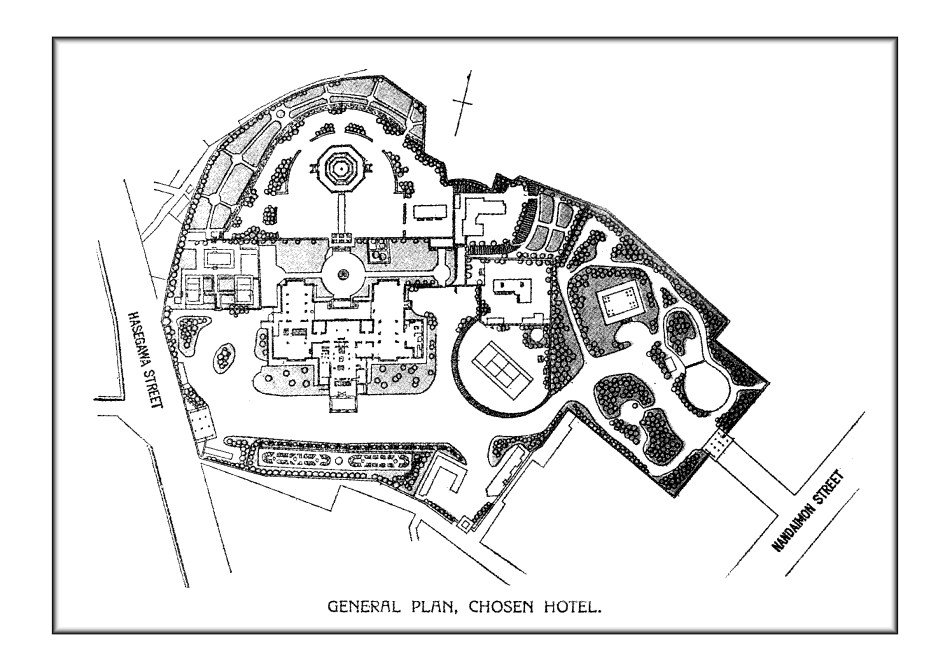
All this is to say that the garden was a lush, colorful place in a growing sea of stone, brick, and concrete. Further suggestive Japanese influence can be seen in a small structure near the wall separating Hwangungu from the hotel building. This might have been a little oinari Shinto shrine, usually constructed along with buildings to bring them good fortune. It is unclear what the large circular, open space to the right of the hotel’s main entrance was used for (pictured in the above plan), but partial images show lines on the ground, suggesting it to be a tennis or badminton court. Photos from the time also indicate that little temporary pavilions were sometimes set up in the rear garden, perhaps used for periodic events or simply to dress up the space on occasion.


A Social History of the Chosen Hotel: Understanding the People Who Stayed There, Their Experiences, the Hotel’s Different Uses, and Its Role Within the Japanese Empire
The Chosen Hotel was first operated by the Chosen Railways for a short time before being taken over by the South Manchuria Railway Company. At least one Japanese manager’s name has been found associated with the hotel, an S. Inohara, who was often absent from descriptions of it. Indeed, the Chosen Hotel, the Busan Station Hotel, and the Shinuiji Station Hotel have been simply described as “represented by Traffic Department, Railway Bureau” while almost all other hotels within the Japan Hotel Association had individual managers’ names connected to them.37 In 1916, in an article reporting on railway developments in Korea, S. Inohara is mentioned as general manager of the Chosen Hotel. He has been included in some English language advertisements for the hotel, too, but in this particular publication he was interestingly implied to be the general manager of all Railway Hotels in Korea.38
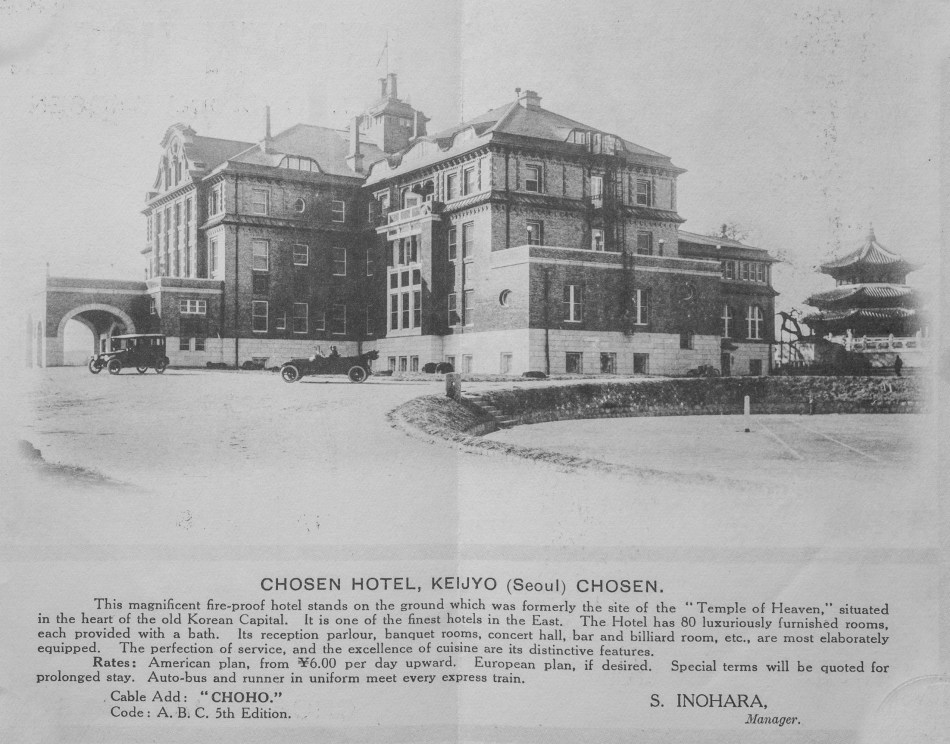
Little is known of Inohara, or of the staff that worked at the hotel during the colonial period, but a travel article published in 1920 by one Virginia Lee praised him for being a “particularly pleasant, obliging manager.”39 (There has also been mention of a Swedish manager at the time of the Korean War, assisted by an unnamed Japanese manager still in the country at the time.40) Throughout the colonial period, the Chosen Hotel and the management of the railways were consistently spoken highly of, suggesting that foreign visitors were always well taken care of. To be sure, one article in the American magazine Travel published in 1916, just two years after the hotel’s completion, overbearingly praised it as a “palatial caravanserai, where the loaf of bread and the jug of wine of civilization are served in such a way as to satisfy the most gilded of Philistines.”41
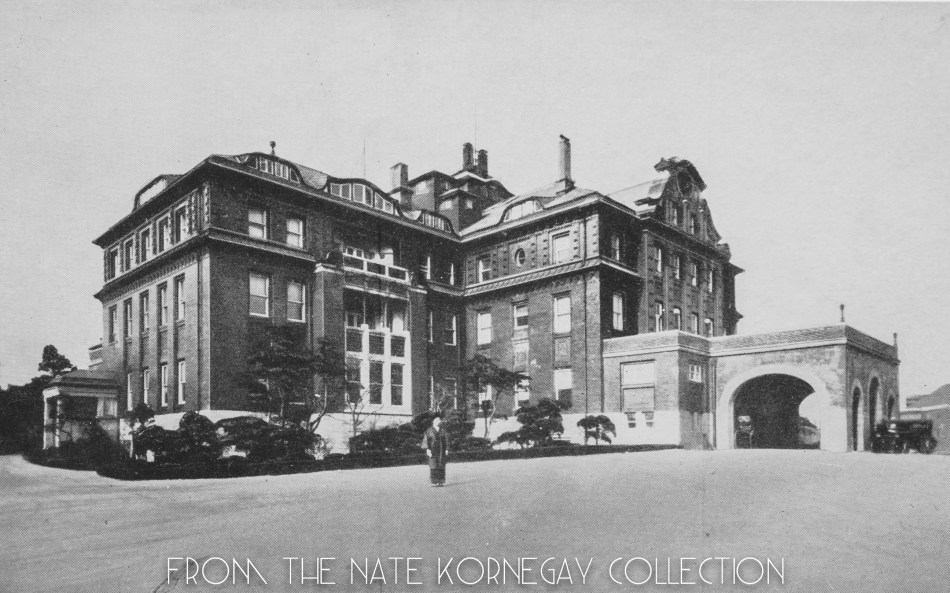
When Marjorie Latta Barstow Greenbie came to the Chosen Hotel, she called it “a hostelry unparalleled in Asia. It combines all the pretty ways and small daintinesses which the Japanese develop for the delectation of Occidentals, with the luxury of real plumbing in the shape of tiled and nickeled bathrooms and hot water in delicious floods. Entranced, like one who has come into a king’s palace in the wilderness, I was led down the noiseless corridor to my pretty room. The boy deposited my baggage and closed the door behind him… [Later] The door opened. A little man beckoned… I passed down the wide stairway, through a room where a fountain played and a Cupid smiled [the Reception Room lounge], out upon a wide veranda that overlooked a garden. An electric sign blazed suddenly like a portent in the heavens. My guide pointed to it. “Movies,” said he. There was a little movie theatre attached to the hotel, and he had come to drum up trade!… I must say that I slept securely that night, blessed with the slumber which comes only to those who have survived two nights on an Asiatic rail- road.42
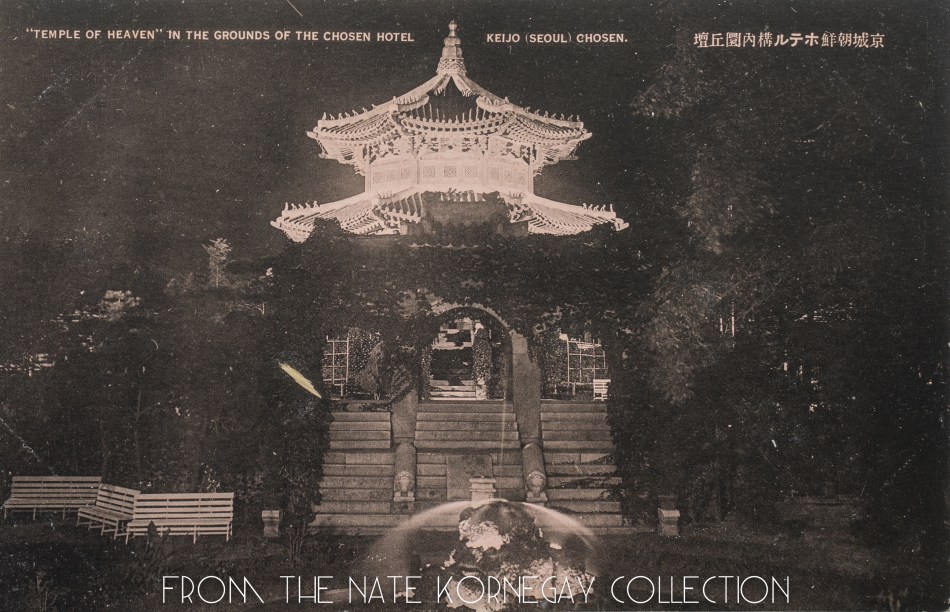
The movies offered to Greenbie, if they were American, may have been obtained through the Morris Trading Co., which distributed for Universal Pictures, or through W.W. Taylor & Co. who distributed MGM and First National films,43 as well Twentieth Century Fox films.44 (Movies from various countries were also available through Japanese dealers). Yet, as some know, Taylor wasn’t only involved in films. With its hands in a number of things, W.W. Taylor & Co. actually operated a branch store known as Ye Olde Curio Shoppe, dealing Korean antiques conveniently located across from the Chosen Hotel. In addition to dealing Korean jade, amber, brass, and furniture that foreign visitors would peruse,45 Ye Olde Curio Shoppe also functioned as an informal tourist information center, taking advantage of its proximity to the Chosen Hotel. The shop referred to its “twenty eight years of experience” in Korea, inviting visitors to “Ask us anything about Korea and we will tell you” and that “this service is FREE and obligates you in no way.”46

If the help of Ye Olde Curio Shoppe wasn’t enlisted by Western visitors, they were able to make more formal inquiries at the nearby tourism office which distributed guide books.47 The hotel’s “menu card” also featured a “‘recommended’ seven days’ sightseeing program.”48 It is unclear what each of the auxiliary buildings on the grounds of the Chosen Hotel were used for, but one mid-1910s to mid-1920s map of Seoul notes a “Chosen Hotel Inquiry Office” and a “Japan Tourist Bureau” on the same site as the hotel itself.49 However, along with a 1926 American travelers’ guide indicating the Japan Tourist Bureau to be in the hotel, the previously pictured ground floor plan labels an information room and a shop in two little spaces on either side of the entry alcove. Therefore, it is unclear which of these information offices were inside and outside of the hotel. This could suggest that the other buildings at the Chosen Hotel were used as offices and the like, maybe changing over time or operating as multi-purpose facilities. Similarly, Greenbie’s explanation of being led outside the main hotel building suggests one of these secondary buildings was used for movies, if not other things.
In these ways, the amenities and services available to patrons of the Chosen Hotel were unrivaled in Korea at the time, so much so that travel writer Archie Bell poetically reflected on the details of his stay in a lengthy anecdote published in 1917:
On arrival, one’s luggage is taken to his room and deposited. Then, if wanted, a hot or cold bath is quickly prepared by an attendant, after which the guest may leave his apartment, absolutely confident, if the keys are deposited in the hands of the room-boy, that every article of clothing will be taken out of trunks and bags, carefully brushed or pressed and hung on racks in a closet or deposited in drawers. Perhaps the guest will dress for dinner. A word to the room-boy, and when one returns he finds everything in readiness, for this personage seem to know instinctively exactly what the “honorable mister” will care to wear, even to the particular collar and necktie. At night the guest goes to his room and finds as he opens the door that a small electric bulb has been left lighted near the head of the bed. A fine kimono and sandals are nearby on a chair, because the guest may care to read a little before retiring. Enter the room at any time of night and a servant usually taps at the door a minute later, asking if anything is wanted.
“Do you care to be called in the morning?”
“No.”
“What time will you be awake?”
“Perhaps seven o’clock.”
And as the hands of the clock reach that exact minute the next morning the Japanese boy enters with a tray on which are a pot of tea, two slices of toast, an orange or other fresh fruit, which he places on a stand at the head of the bed, while he goes to the bathroom and prepares the bath.
And this doglike faithfulness is amply rewards at the end of the week by a fifty-cent “tip.”
“Leaving at noon to-day,” says the guest. He may stay outside his room until eleven o’clock and come back to find every article packed in trunks and bags, much better than he could have arranged himself. Porters take all checking and handling of baggage in charge – for it would not be “correct” to permit a white man to carry any sort of parcel or handbag.50 An automobile with a uniformed chauffeur and footman waits at the front door of the hotel to take guests to the railway station, where another hotel attendant attends to tickets, and usually lifts his cap with “good-by” after he has seen to it that hotel guests have a comfortable seat in a railway carriage.’51
Greenbie and Bell both had nothing but good things to say about the hotel itself. Greenbie gushed over the tiled bathrooms and availability of hot water while Bell went on to say that the “rooms and equipment would compare with an hotel in America.” There was then the matter of dining, of which less commentary can be found. Yet even before the hotel opened its French restaurant, Palm Court, in 1924, Bell was sure to note that the “food at the Chosen Hotel in Seoul would compare favorably with that in a New York hotel or restaurant of the best class.52
For some, all this luxury came at a high cost. In 1925, an irate lawyer from India named Nolini M. Chaterje recalled having to “pay through my nose” for a room with multiple beds.53 Perhaps forced to choose a larger or higher quality room due to the high occupancy of the hotel that evening, the annoyed visitor wrote, “Every evening I looked wrathfully at the unslept bed for it cut a big hole in my pocket.”54 Indeed, by 1926, prices for an ordinary room had jumped to ten yen a night,55 up from six yen a night in 1917. Since the range had increased to 10-20 yen at this time, we can imagine that Chaterje could have paid closer to twenty yen. (Note that 20 Japanese yen was roughly the equivalent of $40 USD in 1926, which had about the same buying power as $560 USD in 2017. This means, in today’s terms, a room at the Chosen Hotel cost between $280-560 per night).56

Other travelers departed their trains with a more grateful attitude than Chaterje. Mrs. Blanche Sellers Ortman wrote, in 1921, that the “beautifully warm, clean rooms and beds, bathrooms perfectly appointed, after the uncomfortable train service of the Japanese Government railways – heated principally with bad air – was a pleasant revelation indeed. Oh the joy of a real bed, and a tiled bath with plenty of hot water! So I crawled beneath the downy comforter with a prayer of thanks that the stork had dropped me down a good U.S.A. chimney, instead of having left me on the roof of a Korean home…”57
By many Western accounts, the Chosen Hotel was a paradise in the middle of a still modernizing Asian “frontier”, even surpassing reputable hotels on the Yokohama Bund in Japan. Edmund Heller wrote in November of 1917, after returning to Japan from Korea, that the Chosen Hotel was “far superior in arrangement” than the old Grand Hotel (opened 1873), making sure to note that his aging room in Yokohama did not have a private bath or running water, unlike the Chosen Hotel.58
But for all of its high praise, the hotel and its later overseer, the South Manchuria Railway Company, were not able to pull the wool over everyone’s eyes. Korea’s urban centers were very much dualistic in nature by 1920, with clear spatial splits between local (Korean) neighborhoods and modern, developed (Japanese) areas.
To be sure, the location of the Chosen Hotel was prime, centrally planted in the business district of Seoul where, over time, a number of banks and commercial institutions, as well as the central post office and department store, sprung up. Greenbie positively remarked on the hotel’s surroundings, noting the many “buildings such as might grace Fifth Avenue itself.”59 Furthermore, the Chosen was just a short walk from Honmachi, the Ginza-like Japanese shopping district in present day Myeong-dong, surrounded by small stores that could meet the desires of visitors from the West or the metropole. In addition to “curiosity” businesses catering to tourists like Ye Olde Curio Shoppe and the Ko Chung Sik Korean Curio Shop located opposite of the Chosen Hotel (on Hasegawa-cho),60 restaurants, Chinese laundries, and photography studios, among other things, could all be easily found around the Chosen.61 It was a significantly developed and, as some Westerners would have surely called it, civilized area.

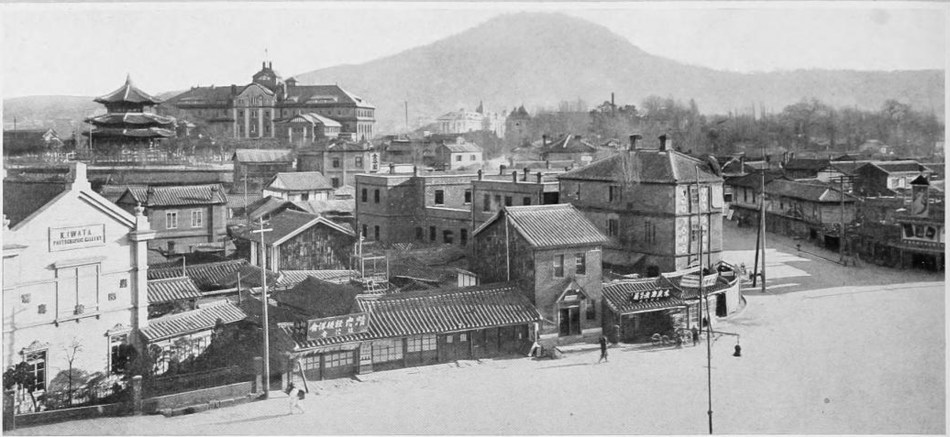
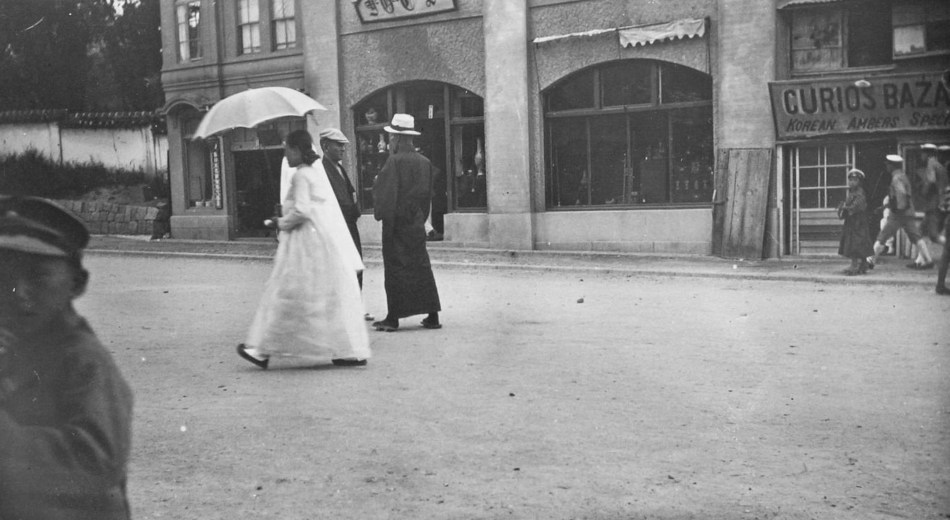
However, an astute Captain Joseph Waddington Graves saw through the veil, past the “prosperous” appearance of Seoul’s “modern public buildings” and its “wide ambitious thoroughfares.” In a section of his book, The Renaissance of Korea entitled “The Apparent and the Real,” Graves noted that this modern city “is the Seoul as seen by the distinguished visitor from America or Europe, who stays a few hours at the luxurious Chosen Hotel and is “shown” the city through the hospitality of the Japanese authorities. The other Seoul, and the real, is found when the modern streets are left, and a journey on feet or by ricksha is taken through the nearby lanes, or more truly alleys. Scenes of squalor and evidences of extreme poverty are on every hand. Seoul under Japanese misrule is a whited sepulchre, and what is true of Seoul is true in the larger sense of Korea. Today there are two Koreas – the Korea of the Japanese, with excellent prospects and an increasing prosperity; and the Korea of the Koreans – moribund, dejected and futureless.”62
This grim description subtracts something from the glamour of early modern downtown Seoul. Indeed, luxury may be hard for the compassionate to stomach when the high cost to some locals is evident just a few streets away. This appears to have been one of the less overt reasons that visitors to the hotel were shuttled around and waited on hand and foot. The South Manchuria Railway Co. – with its railroad network, chain of hotels, transport services, restaurants, and “refreshment rooms” – had significant influence over the ways in which tourists and visitors experienced Korea.
However, those wishing to see the “real” Korea were not going to be stopped. Not more than two hundred meters north of the Chosen Hotel, on the other side of present day Eulji-ro, was a block of Korean hanok.63 It was easy enough to wander outside the main thoroughfares of Seoul in order to experience the “real” Korea, but there were some who preferred comfort over reality. The South Manchuria Railway Co. and its hotels made it easy for visitors to be shielded from the visible realities of Korea’s socio-economic split, with it noted specifically of the Chosen Hotel that, “The stranger leaves Seoul after having been carried around on a bed of roses.”64 Travelers often departed with glowing reviews of their stay at the Chosen Hotel, saying, “Such wonderful service is remarkable in any country, and the traveler is pleased. He feels that Japan is accomplishing wonders in Korea, where travel was formerly such an inconvenience.”65
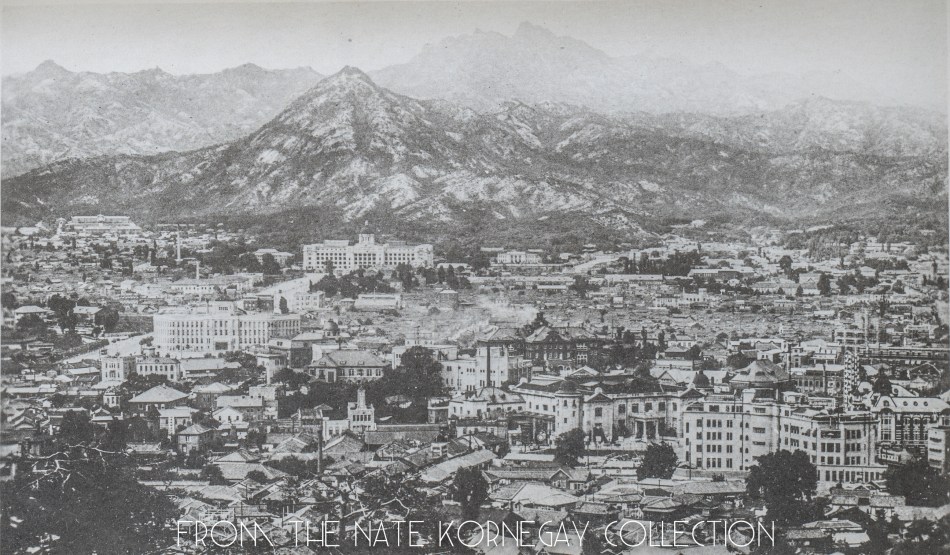
Before he became minister, Henry Chung’s description of Japanese officialdom’s devotion to persuasiveness was more to the point, explaining in 1921 that “the majority of unsuspecting visitors fall into the official trap of the Japanese Government propaganda,”66 and that when visitors were directed to the Chosen Hotel by a “polished official guide” they “must not learn the actual conditions [of Korea] if the Japanese can help it.”67 One visitor’s friend keenly advised that, “If you permit the Japanese to take you in tow at Seoul, you will see only what they want you to see. Insist on studying the conditions for yourself.”68
For returning visitors perhaps taken “in tow,” the impression made by Japanese-led modernization was significant. Frederica A. Walcott, another travel writer, waxed poetic about the views she was met with on her arrival in Seoul, suggesting “it seemed as if Aladdin and his lamp must have been there since my last visit, for in no other way did it seem possible to account for so many changes as had taken place in the old easy-going capital of my five year recollection. Instead of a dark, gloomy station we found a roomy modern building, where we were met by hotel runners in uniform, who escorted us to an American motor-car in which we drove rapidly through well paved electrically lighted streets, where formerly had been dark, muddy roads in fearful condition of filth and lack of repair, to a modern hotel. This new Chosen Hotel, which more than replaces for foreigners Miss Sontag’s famous boarding house of old, has been built by the Japanese-controlled Railway Board with the evident intent of drawing tourists to Korea and popularizing the route to Europe by way of Korea and Manchuria.”69
To be sure, the Chosen Hotel was just one small part in the South Manchuria Railway Company’s tourism campaign, business model, and depiction of Korea itself. Hotels and railways have historically relied on each other. However, under one company, they exercised a lot of influence over visitors and, inevitably, their experience of Korea. Like the irate Chaterje, who seemingly had to resort to paying for an expensive multi-bed room in the Chosen Hotel, visitors unfamiliar with the area, unable to navigate by themselves in a foreign land, or unwilling to accept a native form of hostelry were surely at least one part of the SMR’s tourism scheme. Also part of this scheme were the wealthy travelers and businessmen not there to see the “real” Korea that Graves spoke of.
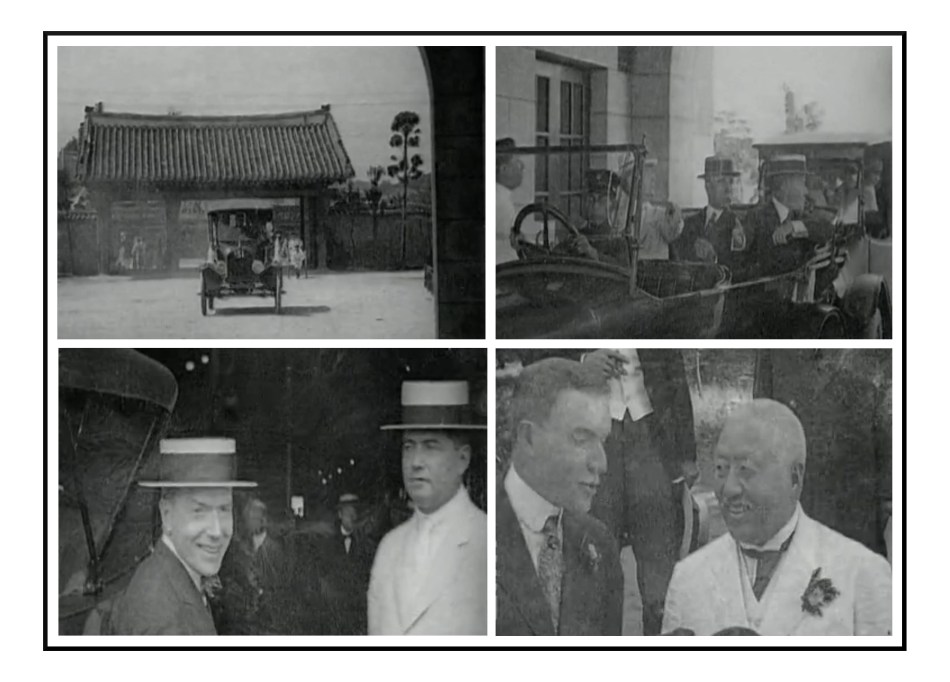
Advertising itself as “The Most Important Link in the Round-the-World Routes via Siberia”,70 the SMR built an empire within an empire – an organization that catered to the travel ideals of comfort and convenience that had become so essential to Westerners. With an office in the middle of New York City, the company made its services easily accessible to American travelers. Hospitality was just one small part of the SMR network, having been involved in everything from education to sanitation. The SMR was granted enormous liberties by both the Japanese government and foreign governments. Like the British East India Company, it was a massive organization with wealth, resources, and a high level of autonomy.
More to the point, the company had a very strong understanding of the power of the press. Placing full page advertisements in various American publications, the SMR was able to push its own agenda by writing these promotional pages so that they (almost) appeared as actual articles within the publication. Essentially propaganda, they justified their industrialization north of Korea with titles such as “The Happy Coolie in Manchuria”, in which the SMR touted itself as a job-creator to hundreds of thousands of poor locals – the bringer of civilization and modernity. 71 Though the SMR was not lying about many of its accomplishments, it was talented at glossing over the negative effects of its actions. As a result, visitors often left parts of the Japanese empire impressed and satisfied, having never gotten a taste of “real” local life.
All this is to say that the ability to control what was being printed and said about Japan’s imperial endeavors was valuable to the central government back in the metropole, as well as the colonial government, so much so that officials routinely checked into the professions, itineraries, and intentions of foreign visitors to Korea.
Unlike the casual traveler, journalists and reporters from abroad were approached with reserved suspicion by Japanese officialdom, likely having a real impact on their stay in Korea. Louis Seibold, a staff correspondent for the New York Herald, was questioned by a police agent regarding his work when boarding the ship for Busan from Shimoneseki. On his arrival, another agent stated he had been made aware of Seibold’s coming, and like “his associate on the Japanese side, he was greatly concerned over my profession and wanted to know what I was going to write.”72 By the time Seibold got to the Chosen Hotel, he had been met by three police agents (in Shimoneseki, Busan, and Seoul) and had filled out five separate “police cards” at each of the hotels he visited.73 Knowing full well the power of the press, Japanese officials used customs-like information cards, including one at the Chosen Hotel, and the telegraph service to keep a clear paper trail of the comings and goings of foreign persons of interest.74 While it is admittedly unclear whether or not this was related to visitor control on the part of the Japanese, Walcott also noted that she made use of a pass obtained from her consulate in Seoul in order to visit Changdeokgung, where the remaining Korean royal family were living out the rest of the Japanese occupation.75 It was in this way that the Japanese government not only directly (and indirectly) restricted and monitored the actions of foreigners, but actively sought to control the presentation of its empire in foreign and local media. This was true of Seoul, the Chosen Hotel, and of some of those involved in the hotel.
During this time, the Hwangungu “Tower of Heaven” was iconicized in published media about Korea, a symbol of the “exotic Orient.” With its silhouette printed on everything from culture pamphlets to the hotel’s actual luggage tags, Hwangungu became a dually recognizable representation of the Chosen Hotel and Korea. The very image of de Lalande’s luxurious nouveau hotel paired with the Korean “pagoda” on postcards epitomized the narrative being pushed of Japan being “the greatest civilizing factor in the far east”, allowing visitors to the Chosen Hotel to superficially experience Korea (via the Tower of Heaven) through the comfort of a Western style hostelry (the Chosen Hotel).
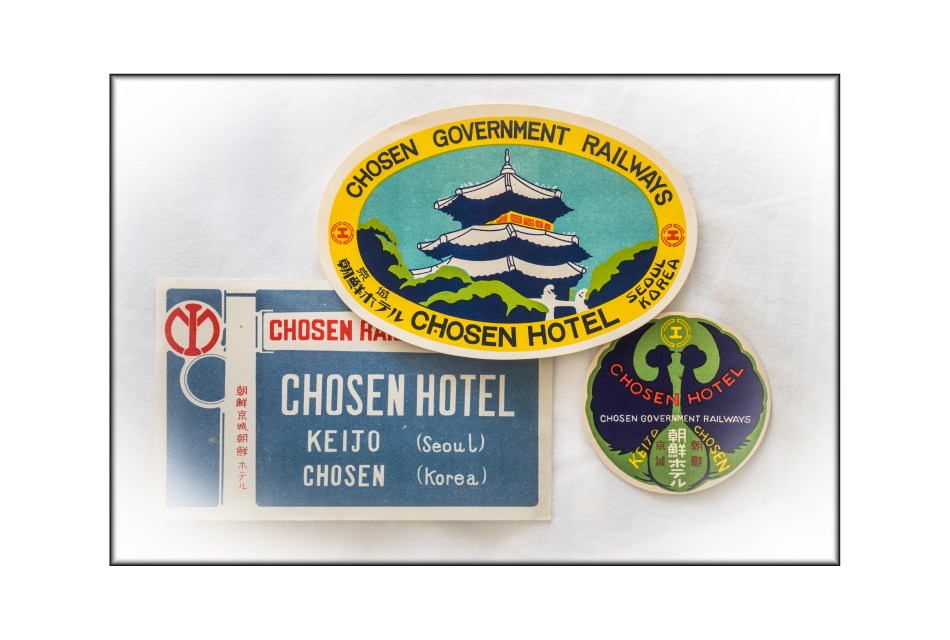
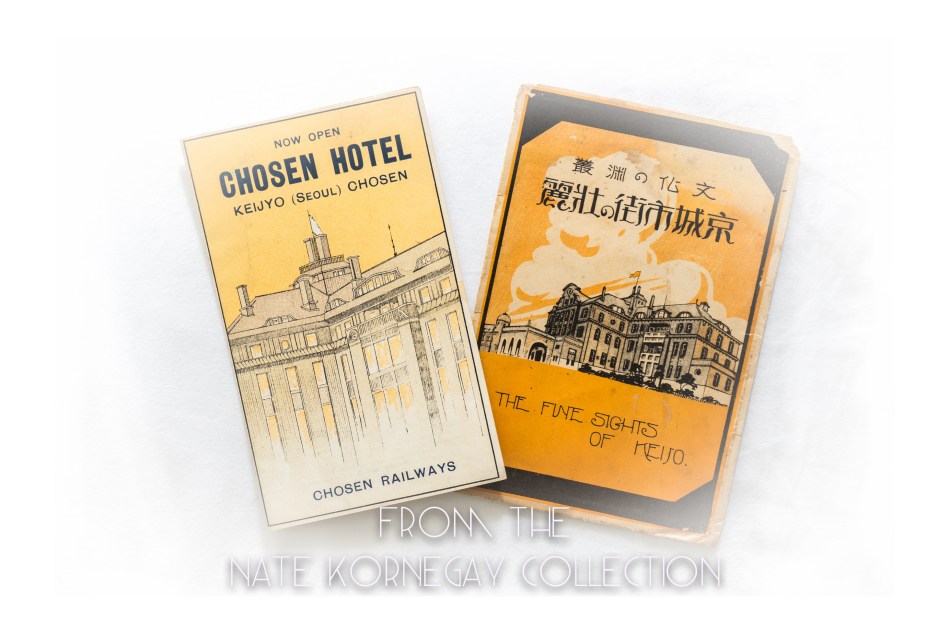
Graves and Chung were keenly aware of this kind of dichotomy, but many others were merely at the Chosen Hotel going about their daily lives. For local well-to do Koreans, Japanese, and Westerners, the Chosen Hotel provided them with one of the only gathering points of a high Western standard. Officials from abroad and expatriates living within Korea had meetings there. Casual social dinners, like one held in honor of Esther Shield’s twenty-five years of medical mission work in Korea, were arranged and enjoyed in the hotel’s dining hall.76 Prominent Koreans, too, like dancer Choi Seung-hee, stopped in for an elegant meal or coffee. The hotel’s ballroom, which held Western styled events such as one hosted by the Belgian consulate in 1915, was also used for more mundane events, like when the Han Yang Lodge (the little known Scottish Freemason group in Korea) held meetings there after their building in Seoul burned in 1925.77 In such cases, the hotel was a part of some locals’ normal lives. It is important to remember that for other visitors, like those on extended vacation or business, the Chosen Hotel was merely one nice stop in a long string of railway operated services.
By the end of the Japanese occupation, competition had grown, and the roughly sixty-five room hotel was starting to look dated amidst the number of modernist hotels throughout Seoul. The Hanto Hotel, built in the format of a big-city American hotel in 1938, was a much larger structure located directly behind the Chosen Hotel. The Chosen could have potentially started to lose business to others, but the outbreak of World War II clearly impacted hostelries everywhere. Indeed, the Pacific theater of WWII had a significant effect on business and travel throughout the empire. In 1942, one Japanese visitor recalled, ‘“After the war started, I came back to Keijo [Seoul] from Tokyo and my friends went to the war. At that time, I just kept going to the bar in the bottom floor of the Chosen Hotel. The Japanese bartender working there would always say, “What’s going to happen [to society] with this war? We are losing customers, especially foreigners.”’78 Though this anecdote is merely one data point in a much larger history, it does perhaps reflect the demographic change of Korea (and the flight of Westerners) towards the end of the Japanese occupation.

The Chosen Hotel in Post-Colonial Korea
By the time of Korea’s liberation, the Chosen Hotel still found use as an important meeting point for high ranking government officials. In September of 1945, a group of U.S. military officers tasked with taking over the Japanese government in Korea arrived in Seoul and were led to a dinner party at the Chosen Hotel hosted by Japanese officers, complete with gisaeng entertainment.79 Then, as the Japanese population exited the country and began the process of repatriation, so the hotel was occupied by U.S. forces. The Chosen then witnessed the turmoil and disorder of the post-colonial situation. One of the auxiliary buildings on the hotel grounds may have been (or converted to) an automobile garage as it was used by both Lt. General Hodge (USA) and Col. General Shtykov (USSR) when they met to negotiate Korea’s fate in 1945.80 A few years later, in 1949, the hotel was then briefly operated by the new Korean government’s Transportation Ministry, under the management of one Chung Hae-sik, with the hotel’s English name officially changed from the Japanese pronounced “Chosen” to the Korean pronounced “Chosun”.81
The hotel was mostly used by the American military during this time, but reporters were sometimes guests, as was the case when the Korean War broke out. The Chosun Hotel was virtually empty then, with only one French reporter staying there as the city evacuated south to avoid the invasion.82 The hotel then changed hands a few times, being occupied by either American, U.N., North Korean, or Chinese forces as battlelines moved. Newsweek called the Chosun “war-battered,” further setting the scene by describing the (unnamed) manager’s flight from the hotel without asking for the visitors’ bills in the beginning of 1951.83
By the end of the war, the “great city of Seoul, the capital, was a shambles.”84 A U.S. Economic Coordinator in Seoul, C. Tyler Wood, noted that the city had impressively rebounded just two months after the armistice signing. When praising the “tough, courageous, and talented” attitude of Koreans, Wood recalled “waking up one night at about 3:00 A.M. and hearing the sound of a hammer pounding. I went to the window of my room in the Chosun Hotel, and there, across the street, were several Koreans working away, rebuilding a structure in the middle of the night.”85
Though it’s been said that the Chosun Hotel survived the war unscathed, it apparently wasn’t kept in good condition. According to Wood, the “conditions under which our aid mission worked were pretty grim, especially in the early days.”86 Wood’s own account describing the Chosun Hotel at the end of the Korean War explained that, “Not much in the way of maintenance had been performed on it in some time, and it was hardly the lush living of the “you never had it so good” type we sometimes hear people claim we enjoy. For one thing, we all became well acquainted with rats from close association with them. During the first winter, at the onset of the cold weather, we started the heating system and the ancient boilers, but unequal to the task, they just quit. We lived for about two months, during which time the temperature often went below freezing, with only Army space heaters to warm us. We couldn’t have these heaters in our rooms, and they were used only in the dining room and the lobby downstairs. The Army fire regulations forbade – a wise rule – having space heaters in individual rooms. . .”87
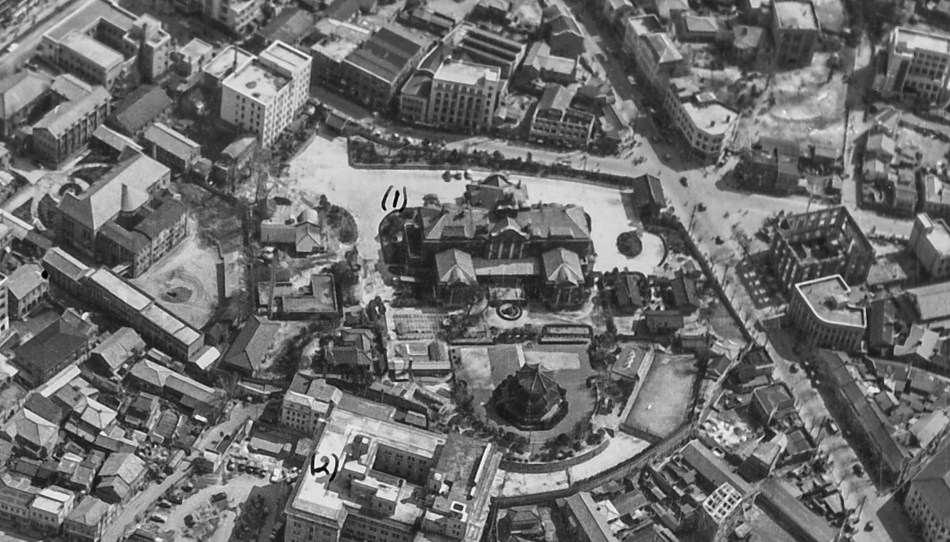
This was in a building that had just been renovated in a few years earlier by the Korean Transportation Ministry in 1949,88 suggesting that the rough manner in which it was treated during the war had actually done something to rob the once luxurious structure of its former glory. To be sure, it is unclear what happened exactly when the North Korean and Chinese forces occupied the building aside from pillaging its food stores.89 Reportedly, the hotel was “all but empty of mattresses and furniture,” 90 but the lobby was still adorned by Merry Christmas and Happy New Year signs, and the dining room still contained its New Year party menus when U.N. forces retook Seoul for the last time.91 It was said that “Nowhere in the few intact buildings [in Seoul] did the plumbing work.”92 A military medic specifically confirmed this was true of the Chosun Hotel, explaining that since “the toilet bowls could not operate without water, they were particularly offensive.”93 Furthermore, the hotel received damage “from some twenty-millimeter cannon shells” at the hands of U.N. forces, and had been left in a “filthy condition” by North Korean and Chinese forces.94
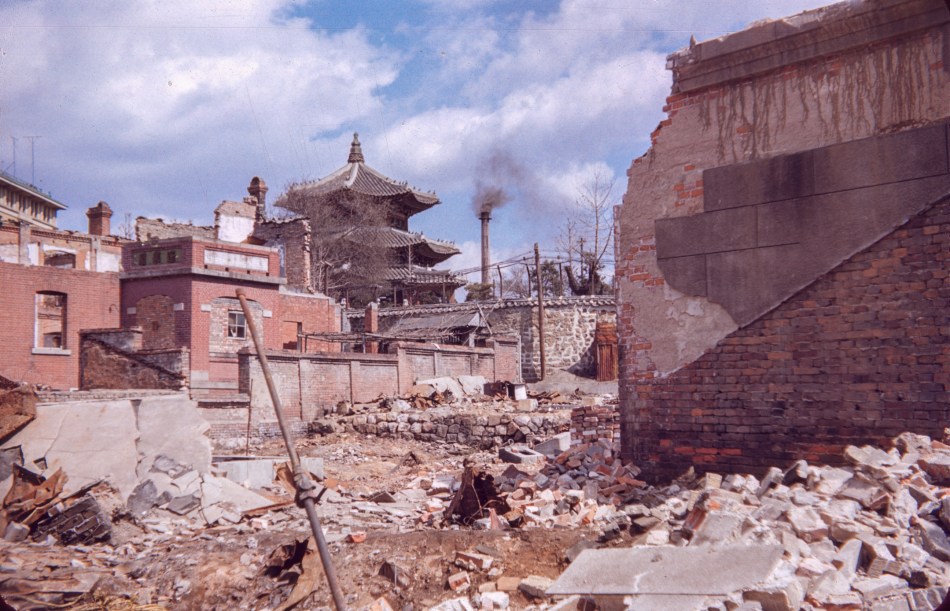
Wood proceeded to report that the hotel was refurbished again after his stay there, finally calling it “a comfortable place to live in.”95 It has been said that employees of the Agency for International Development, of which Wood was involved, repurposed a basement space for their own leisure purposes, dubbing it the Wood Room.96 It is unclear whether or not the naming of this hangout spot was connected to C. Tyler Wood, but given that he was staying at the Chosun Hotel with the AID, it would not be unreasonable to assume that he had something to do with the naming of this space.

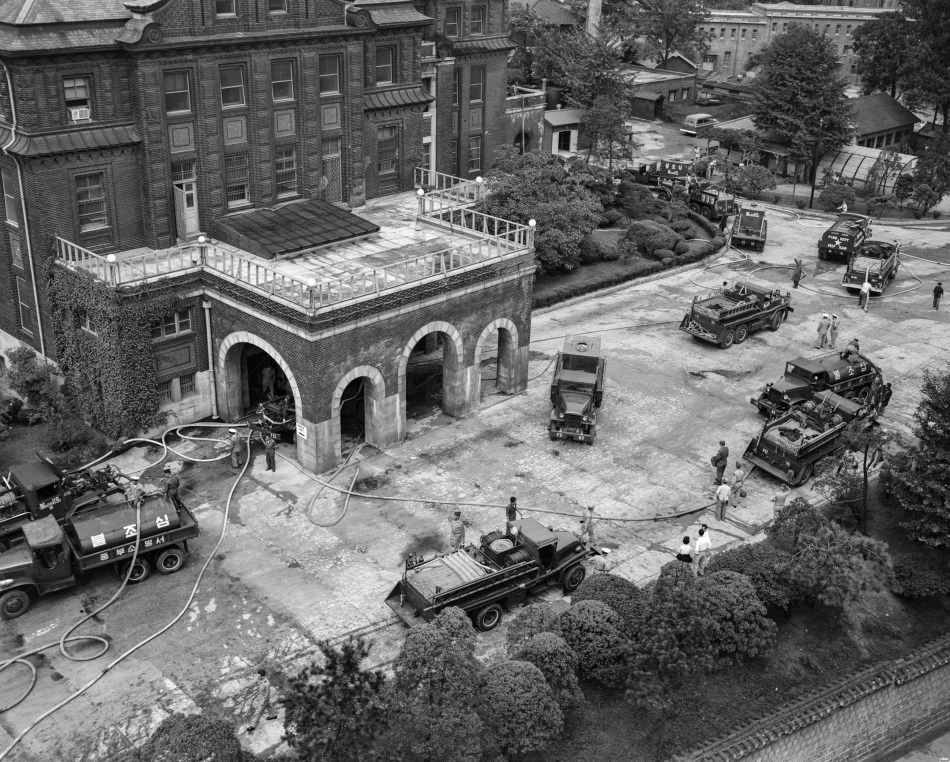
About two years after Woods’ publication ran in October 1956, misfortune struck again as the recently “refurbished” hotel caught fire. The hotel survived, and renovation work began again in 1960, along with remodeling the hotel for residential use by Chang Myon, the second prime minister of South Korea, “but the project was dropped when . . . Chung Hee Park overthrew the Chang regime in 1961.”97 Through all these trials, the hotel remained. The Chosun Hotel retained its reputation for old world elegance into the 1960s, even catering to the Blue House under Park Chung-hee. It was handed back over to the Korean government’s Transportation Ministry in 1961, at which point it underwent another renovation,98 but by this time industrialization was catching up with the aging building.
An increasingly dense Seoul led to part of the garden being paved over as a parking lot, with the secondary buildings being converted into villas;99 in response to the Chosun Hotel’s high occupancy rate and Korea’s growing tourism industry, a shopping arcade was built between it and the Bando Hotel in 1965. The following year reportedly had almost double the number of visitors to Korea as the year prior.100 Along with growing information circulating in the West about the industrializing country, PanAm published a business guide suggesting that the Chosun and Bando were still the most important hotels in Korea.101 The guide priced a single room at the Chosun from $9.00 and the Bando from $7.10 (European plan, meals excluded), with further information showing these hotels were some of the only options for serious businessmen and business entertainment in Korea.102

Despite its continual success, the once iconic building was becoming an inefficient hotel in an increasingly fast-paced and overcrowded city. A number of modern hotels, like the Walker Hill Resort, the Grand Hotel, and the then up-and-coming Tower Hotel (now Banyan Tree), were all sure to compete with the tired Chosun. In the year leading up to its demolition, demand for rooms reportedly doubled;103 the Chosun Hotel simply couldn’t accommodate everyone anymore. It was then demolished in 1968, interestingly the same year as Tokyo’s analogous Imperial Hotel.104
The New York Times called it a controversial decision, with one group arguing for the hotel’s historical significance while the other claimed “the four-story brick structure has posed constant maintenance problems in recent years. Its floors were creaking and the plumbing leaking. Two elevators of old world style that looked like “gold birdcages” were virtual antiques.”105 Indeed, maintenance was becoming difficult and parts of the hotel were severely outdated, with its elevators as old as the hotel itself.106
An auction was held and practically everything, including the trees on the hotel grounds, were sold off.107 The air conditioning units, too, changed hands, making their way to the Chosun’s future competitor, the Tower Hotel (opened in 1969).108 As the new Chosun Hotel was constructed, the only thing that remained was the old Hwangungu “Tower of Heaven”, a little ceremonial building that stood as witness to the turbulent, roller-coaster ride of Korea’s modern history. The pavilion can still be found at Wongudan on the grounds of the Westin-Chosun today, hidden in a few square meters engulfed by Seoul’s urban high-rises.
This article is the second in the series, Reading and Understanding Early Modern Architecture in Korea. It seeks to help both the scholar and general public in deconstructing and contextualizing specific aspects of early modern architecture in Korea. If this article has helped you, if you see a point that you’d like to discuss, or if you would like to collaborate on a project, please feel free to comment below or send a private message via the contact form. The first in this series was “Early Modern Brick and the Perforated Qing Cross“.
Footnotes and Citations
1Blanche Sellers Ortman, New York to Peking (San Francisco: 1921), 94. This book was apparently printed privately by Bruce Brough without a major book publisher, as indicated in the text itself, with only 210 copies originally made.
2E. Alexander Powell, Asia At The Crossroads (London: T. Fisher Unwin Ltd., 1922), 112.
3Ludwig Richard Seel, who had worked with de Lalande in China, was a German architect with connections to the influential Berlin firm, Ende and Böckmann. Seel and de Lalande probably met in China, where both of them worked together. It was during that time that the two architects likely struck up a deal. Since Seel wished to return to Europe, de Lalande took over his architectural firm in Yokohama.
4Basic information on de Lalande’s life and completed works can be found on Japan Architect, an online English language database.
5The Chosun Hotel: 100 Years (Seoul: Shinsegae Chosun Hotel, 2014), 23. This is a centennial book published by the hotel itself. It should be noted that it does not cite many of its sources for the information given in the text; it doesn’t even give a print date, but I presume it to be 2014 since it is a centennial book. As such, I encourage readers here to take any of the information quoted from this book with a grain of salt. It’s probably correct, but it needs to be fact checked.
6See Shoji tomita, hoteru to nihon kiundai. Note that Shimizu was corporatized as Shimizu Gumi in 1915, but it was still a private company at the time of the Chosen Hotel’s construction.
7 The Chosun Hotel: 100 Years (Seoul: Shinsegae Chosun Hotel, 2014), 23
8The Directory and Chronicle for China, Japan, Corea, Indo-China, Straits Settlements, Malay States, Siam, Netherlands India, Borneo, Philippines, &c. (Hong Kong: Hong Kong Daily Press, Ltd., 1920), 570.
9Alternatively, de Lalande may have been in Korea on business related to his design for the Government-General building. The details of his visit to Korea in 1914 are unclear. Even if he went there for work specifically related to the Government-General building, which he was originally to design, it would be unlikely that he did not stop by the Chosen Hotel to at least have a look.
10 The Chosun Hotel: 100 Years (Seoul: Shinsegae Chosun Hotel, 2014), 23
11See the article on page 1 and page 4 of the Real Estate Section: “Chosun Hotel, a Seoul Landmark, Will Be Razed for a Skyscraper,” New York Times, August 6, 1967.
12 The Chosun Hotel: 100 Years (Seoul: Shinsegae Chosun Hotel, 2014) 30
13Historian Jihoon Suk is to credit for not only recognizing the Chinese character for longevity on the Chosun Hotel’s facade, but also for specifically connecting the Chosun Hotel’s kkotdam design to Gyeongbokgung’s kkotdam.
14See the article on page 1 and page 4 of the Real Estate Section entitled: “Chosun Hotel, a Seoul Landmark, Will Be Razed for a Skyscraper,” New York Times, August 6, 1967.
15The architectural office of the Government-General similarly altered de Lalande’s plans for the 1926 Government-General Building in front of Gyeongbokgung, which was originally a rather run-of-the-mill Neoclassical building. Furthermore, other architects in de Lalande’s office had designed non-Western buildings, like the entirely Japanese-styled Matsushima Park Hotel (1913), implying that Lalande may have been able to implement Asian architectural elements into the Chosen Hotel if he had wanted to.
16Japanese architects did start fusing native architecture into modern buildings, especially in Manchuria, as a part of growing nationalism leading up to World War II, but this was decades after the Chosen Hotel was built. There were few cases prior to this, with some in Korea perhaps being the old Suwon Station and a museum in Seoul. Certainly no hotel featured native architecture like this, though, at the time of the Chosen Hotel’s construction.
17For more on the concept of Koreana, see E. Taylor Atkins’ book of the same title, which discusses how some Japanese settlers were interested in Korean culture and artifacts, often as a means by which they could view their perceived formerly uncivilized selves.
18Thomas Cook Ltd., Peking, North China, South Manchuria and Korea (London: T. Cook & Son, 1920), 142.
19Willard Price, Key to Japan (London: William Heinemann Ltd., 1946), 142-143.
20Willard Price, Key to Japan (London: William Heinemann Ltd., 1946), 143.
21 The Chosun Hotel: 100 Years (Seoul: Shinsegae Chosun Hotel, 2014), 32.
22Willard Price, Key to Japan (London: William Heinemann Ltd., 1946), 142. Note that it is possible that Price was exaggerating about the Steinway piano, for an almost identical text was published in article form prior to his book, Key to Japan, in which he simply said there was a piano at the Chosen Hotel. In Key to Japan, Price either expanded on details left out in his previous article, or embellished in order to spice up the story. Therefore, it is unclear why the first article didn’t mention the piano as being a Steinway.
23 The Chosun Hotel: 100 Years (Seoul: Shinsegae Chosun Hotel, 2014), 23
24 The Chosun Hotel: 100 Years (Seoul: Shinsegae Chosun Hotel, 2014), 23
25Peking and the Overland Route (London: Thos. Cook and Son, 1917), 131.
26Pictorial Chosen and Manchuria (Seoul: Bank of Chosen, October 1919), 60.
27Willard Price, Key to Japan (London: William Heinemann Ltd., 1946), 143.
28 The Chosun Hotel: 100 Years (Seoul: Shinsegae Chosun Hotel, 2014), 23
29 The Chosun Hotel: 100 Years (Seoul: Shinsegae Chosun Hotel, 2014), 31
30 The Chosun Hotel: 100 Years (Seoul: Shinsegae Chosun Hotel, 2014), 39
31 E. Alexander Powell, Asia At The Crossroads (London: T. Fisher Unwin Ltd., 1922), 112.
32 Overland Monthly (San Francisco: A. Roman & Company, 1921), 52.
33 Arnold Arboretum, Arnoldia (Massachusetts: Harvard University, 1968), 30. Note that in addition to information provided by Arnoldia and the Plant Inventory, there was an entry in Edmund Heller’s diary dating to October 29, 1917, in which Heller noted that Ernest Wilson, the individual who took seeds from the Chosen Hotel’s pink silk trees, was exploring the islands near Busan while his wife and daughter were waiting for him at the Chosen Hotel. This places Ernest Wilson’s discovery of the pink silk tree at the Chosen Hotel to around 1917. Presumably, the Plant Inventory’s information on the Japanese prickly ash and Asian vine at the Chosen Hotel came from around this time as well, even though their information wasn’t published until 1929 in Plant Inventory.
34 Gōkan no hana (nemu no hana) banka, Kigosai.
35 Plant Inventory (Washington D.C.: United States Department of Agriculture, October 1929), 24.
36 Plant Inventory (Washington D.C.: United States Department of Agriculture, October 1929), 41.
37Hakurankwai Kyokwai, ed., Japan and Her Exhibits (Tokyo: Société des Expositions, 1915), 18-19.
38“Construction Work in Chosen,” Building and Engineering News (San Francisco: L. A. Larsen, 1916), 29.
39Virigina Lee, “Asia’s Travel-Log,” Asia (Concord: Asia Publishing Company, 1920), 538.
40 The Chosun Hotel: 100 Years (Seoul: Shinsegae Chosun Hotel, 2014), 69.
41Gertrude Emerson and Elsie F. Weil, “Korea, Japan’s Willing Vasal,” Travel (New York: Robert M. McBride & Co., 1916), 10-11.
42Marjorie Barstow Greenbie, In The Eyes Of The East (New York: Dodd, Mead and Company, 1921), 151-152.
43Brian Yecies and Ae-Gyung Shim, Korea’s Occupied Cinemas, 1893-1948: The Untold History of the Film Industry (New York: Routledge, 2011), 64.
44Jack Alicoate, ed. The 1942 Film Daily Year Book of Motion Pictures (New York: The Film Daily, 1942), 560.
45Karl Vogel, Aloha Around the World (New York: G. P. Putnam’s Sons, 1922), 84.
46See the brochure entitled Chats on Things Korean, published in Seoul for W.W. Taylor & Co. to promote their branch store, Ye Olde Curio Shoppe. Little else is known about this document, but it was part of former ambassador Martin Uden’s collection of Korea related texts. It probably dates sometime between 1900 and the 1930s.
47H. B. Drake, Korea of the Japanese (London: John Lane the Bodley Head Limited, 1930), 50.
48Lucian Swift Kirtland, Finding the Worth While in the Orient (New York: Robert M. McBride & Company, 1926), 104.
49See a pre-1926 English language map, almost certainly Japanese made, simply titled “Keijyo (Seoul)” which became part of a foreign service report now found in the (U.S.) National Archives and Records Administration.
50Sensitive and sympathetic to matters of ethnicity, Bell mentions that the “white man” cannot touch luggage precisely because he disagreed with the racism he encountered between Westerners and Asians while visiting Korea, particularly a case in which an American military officer spouted expletives after being confronted about his rudely pushing the locals out of his way with a stick. Archie Bell, The Spell of China (Boston: The Page Company, 1917), 382.
51This entire quote is from: Archie Bell, The Spell of China (Boston: The Page Company, 1917), 379-381.
52Archie Bell, The Spell of China (Boston: The Page Company, 1917), 381.
53Nolini M. Chaterje, The World Civilization of To-day or The Far East and the New West (Calcutta: The Book Company, 1925), 116.
54Nolini M. Chaterje, The World Civilization of To-day or The Far East and the New West (Calcutta: The Book Company, 1925), 116.
55See Commercial Travelers’ Guide to the Far East (Washington D.C.: Government Printing Office, 1926), 48-49. This document appears to have been part of a Trade Promotion Series supported by the Department of Commerce.
56These figures are based on Wikipedia’s Tables of historical exchange rates to the United States dollar, where 2 JPY is shown to be the equivalent of $1 USD, and the CPI Inflation Calculator on the United States Department of Labor’s website. This is a quick calculation, meant to give readers a ballpark estimate of what a room at the Chosen Hotel would cost us in today’s terms. I recognize that these numbers might be somewhat inaccurate.
57Blanche Sellers Ortman, New York to Peking (San Francisco: 1921), 94. This book was apparently printed privately by Bruce Brough without a major book publisher, as indicated in the text itself, with only 210 copies originally made. It should be noted, to be sure, that when Ortman called the hotel’s chimney a “good U.S.A. chimney”, her words did not mean that the hotel had a literal American-made chimney.
58Edmund Heller, The Diary of Edmund Heller, October 9, 1917 – January 12, 1918, ed. Frederic A. Sharif. Library of the American Museum of Natural History., 51.
59Marjorie Barstow Greenbie, In The Eyes Of The East (New York: Dodd, Mead and Company, 1921), 151-152.
60It should be noted that there were striking similarities between the photos of ads for Ye Olde Curio Shoppe and the Ko Chung Sik Korea Curio Shop. Not only did they advertise seemingly identical products, but they were both next to the Chosen Hotel. One ad for Ko Chung Sik shows a map visually indicating their shop opposite of the Chosen Hotel. Ads for Ye Olde Curio Shoppe stated “Opposite Chosen Hotel.” It’s possible these two stores were actually the same store, either being promoted using two different names or having changed ownership. It’s certainly possible Taylor sold Ye Olde Curio Shoppe.
61This comment is based on brochures by Ye Olde Curio Shoppe and Ko Chung Sik’s shop, photos showing Japanese sign names on nearby shops, and Western accounts. The Chinese laundry is casually mentioned in Gertrude Emerson and Elsie F. Weil, “Korea, Japan’s Willing Vasal,” Travel (New York: Robert M. McBride & Co., 1916), 11.
62Joseph Waddington Graves, B.D., The Renaissance of Korea (Philadelphia: Philip Jaisohn & Co., 1920), 47.
63This is based on aerial views of the area between 1940s-1950s.
64Archie Bell, The Spell of China (Boston: The Page Company, 1917), 381.
65Archie Bell, The Spell of China (Boston: The Page Company, 1917), 381.
66Henry Chung, A.M, Ph. D., The Case of Korea (New York: Fleming H. Revell Company, 1921), 249.
67Henry Chung, A.M, Ph. D., The Case of Korea (New York: Fleming H. Revell Company, 1921), 248.
68Henry Chung, A.M, Ph. D., The Case of Korea (New York: Fleming H. Revell Company, 1921), 249.
69Frederica A. Walcott, Letters from the Far East (Vermont: The Elm Tree Press, 1917), 38. This text was another one privately printed without a publisher. It indicates that originally there were only one hundred books made.
70Peking and the Overland Route (London: Thos. Cook and Son, 1917), xxiiii.
71See the back section of Volume 44, May to October 1922, of The World’s Work Advertiser – Travel, where the advertisement pages are unnumbered. “The Happy Coolie in Manchuria,” The World’s Work 44 (New York: Doubleday, Page & Company, 1922).
72Louis Seibold, Japan: Her Vast Undertakings and World Expansion (New York: New York Herald, 1921), 89. Note that this book was published as a series of previously published newspaper articles Seibold had written for the New York Herald.
73Louis Seibold, Japan: Her Vast Undertakings and World Expansion (New York: New York Herald, 1921), 89.
74Louis Seibold, Japan: Her Vast Undertakings and World Expansion (New York: New York Herald, 1921), 89.
75Frederica A. Walcott, Letters from the Far East (Vermont: The Elm Tree Press, 1917), 38.
76“Nursing News and Announcements,” The American Journal of Nursing (Philadelphia: J. B. Lippincott & Co., 1922), 63.
77“Proceedings,” The Heritage Lodge No. 730, A.F. & A.M., G.R.C., 12 (Guelph: 1989), 18.
78Shoji Tomita, Hoteru to nihon kiundai (Tokyo: Seikyusha, 2003), 208. In this book, Shoji is quoting Medemiru sekijitsu no chosen, a primary source from which this 1942 quote is taken. The English quote here is a casual, inexact translation from Shoji’s Japanese-language book.
79Yuki Tanaka, Japan’s Comfort Women (New York: Routledge 2002), 86.
80William van Narvig, East of the Iron Curtain (Chicago: Ziff Davis Publishing Company, 1946), 295.
81The Chosun Hotel: 100 Years (Seoul: Shinsegae Chosun Hotel, 2014), 65
82The Chosun Hotel: 100 Years (Seoul: Shinsegae Chosun Hotel, 2014), 69
83“Falling Back-But Fighting Back,” Newsweek (New York: 1951), 33.
84C. Tyler Wood, “Korea: 1953-1956,” The Shield, 19, 4 (The ICA Social Organization: October 15, 1956), 1.
85C. Tyler Wood, “Korea: 1953-1956,” The Shield, 19, 4 (The ICA Social Organization: October 15, 1956), 5.
86C. Tyler Wood, “Korea: 1953-1956,” The Shield, 19, 4 (The ICA Social Organization: October 15, 1956), 5.
87C. Tyler Wood, “Korea: 1953-1956,” The Shield, 19, 4 (The ICA Social Organization: October 15, 1956), 5.
88The Chosun Hotel: 100 Years (Seoul: Shinsegae Chosun Hotel, 2014), 65
89The Chosun Hotel: 100 Years (Seoul: Shinsegae Chosun Hotel, 2014), 69
90“Falling Back-But Fighting Back,” Newsweek (New York: 1951), 30
91“Falling Back-But Fighting Back,” Newsweek (New York: 1951), 30..
92“Falling Back-But Fighting Back,” Newsweek (New York: 1951), 30.
93Crawford F. Sams, Medic: The Mission of an American Military Doctor in Occupied Japan and Wartorn Korea (New York: Routledge, 2015), 225. This text was first published in 1997-1998 by M. E. Sharpe.
94Crawford F. Sams, Medic: The Mission of an American Military Doctor in Occupied Japan and Wartorn Korea (New York: Routledge, 2015), 225.
95C. Tyler Wood, “Korea: 1953-1956,” The Shield, 19, 4 (The ICA Social Organization: October 15, 1956), 5.
96The Chosun Hotel: 100 Years (Seoul: Shinsegae Chosun Hotel, 2014), 84.
97See the article on page 4 of the Real Estate Section entitled: “Chosun Hotel, a Seoul Landmark, Will Be Razed for a Skyscraper,” New York Times, August 6, 1967.
98The Chosun Hotel: 100 Years (Seoul: Shinsegae Chosun Hotel, 2014), 101.
99The Chosun Hotel: 100 Years (Seoul: Shinsegae Chosun Hotel, 2014), 101.
100See the article on page 4 of the Real Estate Section entitled: “Chosun Hotel, a Seoul Landmark, Will Be Razed for a Skyscraper,” New York Times, August 6, 1967.
101Richard G. Lurie, Passports and Profits: Pan Am’s Guide to Doing Business in 105 Countries (Doubleday & Company: New York 1964), 501.
102Richard G. Lurie, Passports and Profits: Pan Am’s Guide to Doing Business in 105 Countries (Doubleday & Company: New York 1964), 501.
103See the article on page 1 and page 4 of the Real Estate Section entitled: “Chosun Hotel, a Seoul Landmark, Will Be Razed for a Skyscraper,” New York Times, August 6, 1967.
104The New York Times actually made this same comparison in 1967, implying the Chosun Hotel was the Korean equivalent of Tokyo’s Imperial Hotel. Though it is speculation, one wonders whether or not the similar timing was influenced by modernization trends.
105See the article on page 4 of the Real Estate Section entitled: “Chosun Hotel, a Seoul Landmark, Will Be Razed for a Skyscraper,” New York Times, August 6, 1967.
106See the article on page 4 of the Real Estate Section entitled: “Chosun Hotel, a Seoul Landmark, Will Be Razed for a Skyscraper,” New York Times, August 6, 1967.
107The Chosun Hotel: 100 Years (Seoul: Shinsegae Chosun Hotel, 2014), 113.
108The Chosun Hotel: 100 Years (Seoul: Shinsegae Chosun Hotel, 2014), 113.
*The spelling “Chosen Hotel” is used when discussing the hotel’s history up until its name change around 1949, after which the spelling “Chosun Hotel” is used. The author has opted to do this in order to show how it was popularly and officially referred to at the time. The word “Joseon” is used as a literal translation of 조선 to discuss the time and government before Japanese colonialism and Gojong’s declaration of the Korean Empire. Sorry if the various English spellings of the same word are confusing.
*Though detailed, this article is not a fully-comprehensive history of the Chosen Hotel, nor does it intend to compete in any way with other sources such as the Westin-Chosun’s centennial book, which offers more information on the Korean perspective of the hotel. For a history featuring more of a Korean perspective, as well as the hotel’s history after 1970, please go buy a copy of this book. (Yes, I know, it’s hard to find). This article has been published to educate, to encourage discussion, and to raise public awareness of a lost part of Korean architectural history.
ALL IMAGES AND PHOTOS ARE COPYRIGHTED UNLESS OTHERWISE NOTED. SOME IMAGES FEATURED HERE MAY BE UNDER COPYRIGHT, BUT ARE USED HERE FOR EDUCATIONAL, NON-COMMERCIAL PURPOSES UNDER STANDARD RULES OF FAIR USE. PLEASE DO NOT REPRODUCE OR DISTRIBUTE WITHOUT PERMISSION. IMAGES WITHOUT A SOURCE ARE ASSUMED TO BE THE COPYRIGHT OF NATE KORNEGAY. PLEASE DO NOT REPRODUCE OR DISTRIBUTE IMAGES FROM “COLONIAL KOREA” OR THE NATE KORNEGAY COLLECTION WITHOUT PERMISSION.
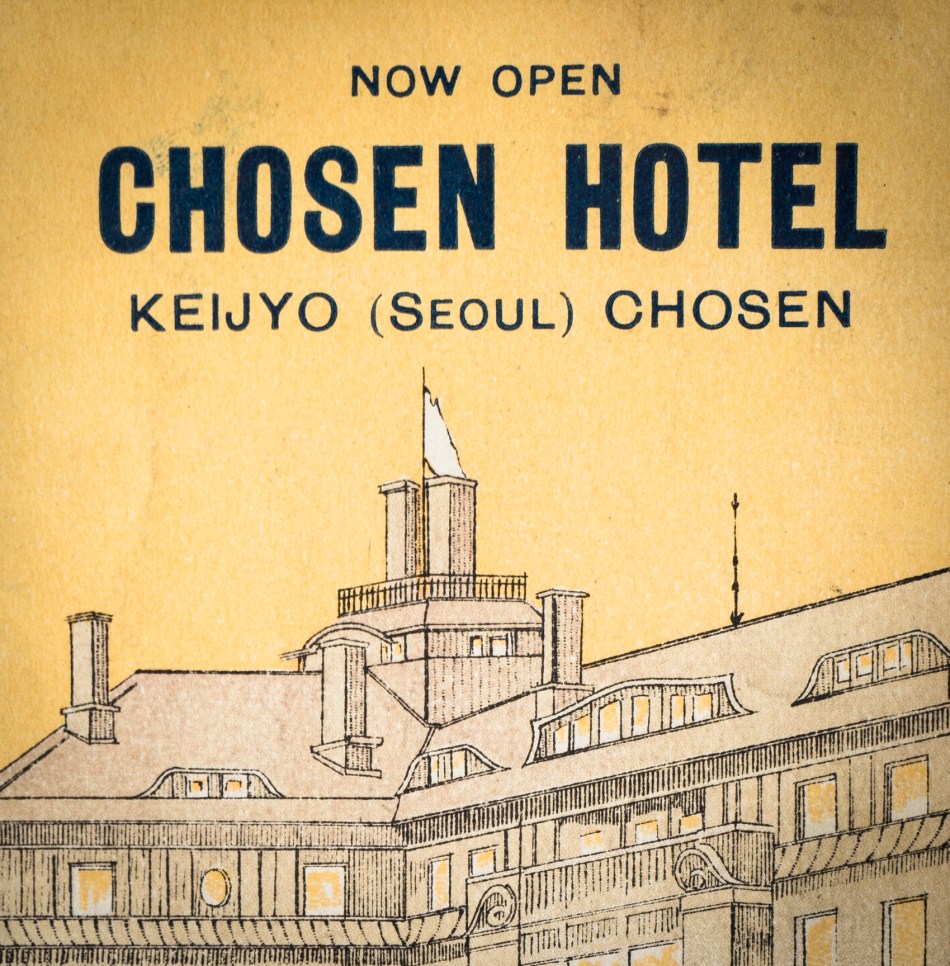
Truly an interesting, if not fascinating, read. Thanks for your expansive and well-researched post.
LikeLike
Thanks for your kind words and taking the time to comment! I’m glad you found it informative.
LikeLike
Fascinating and detailed history. I sometimes work on images posted by Doug Price, generally cleaning them of debris and seeing if the colour and contrast can be restored. I will check my sets and post on Flickr if I have any of those you’ve posted here. You can use if you wish.
LikeLike
Thank you! I’ve come across some more information about the hotel and am planning an updated rewrite in the future. Thanks for your offer, I’d love to see your edited images.
LikeLike
Here is a link to a reworked version of one of the photos.
https://www.flickr.com/photos/theonemacduff/46389578331/in/photostream/
LikeLike
Thanks, that looks better.
LikeLike
It was an architectural heritage that was lost to modern city development, replaced with a bland and imposing high-rise. Where’s the history? If it were to survive today, it would definitely would have been truly wonderful to see.
But considering how Koreans are negligent upon surviving colonial-era architecture even up to today, I’d suspect that this building wouldn’t have made it through the 80s, probably long gone by the 90s.
With this and the old Gyeonggido provincial government office (demolished in the 1990s, turned into an empty plaza) in front of Gwanghwamun still standing, this neighborhood would have been somewhat less bland of a place.
Great write-up and extensive research on this landmark.
LikeLike
Thanks for your comments and kind words. I’ve found some more information on the hotel since I wrote this, which I’m considering featuring in another project with a much broader view. Could be a long while before it is ready, however. I’ll update this blog post here if/when that project is finished. Thanks again and I’m glad you found it informative!
LikeLike
Now i am working for the Chosun hotel. Reading your article was like a travelling to the past.
I am deeply moved by your article. Particularly, all those photos brought me back in early 1900s.
Thanks you for all the informative articles and pictures.
LikeLike
Thank you for your kind words, and I’m so happy to know that you found it informative.
LikeLike
I enjoyed your article, my Grandfather was the front desk clerk of the Chosun hotel during the Korean war for 3 years. I have a original menu of one of the dinners prepared for General Maxwell Taylor. I have dozens of photos of the grounds, the soldiers and staff of the hotel from this period of 1952-1954. I will attempt to scan them soon and send them over in you are interested.
Cheers,
Brendan Amoruso
LikeLike
Hi, Brendan. Thank you, and this is very exciting information! I’ll email you about it shortly. Thanks for sharing!
LikeLike
Pingback: South Korea’s Newest Luxury Hotel Opens In Seoul – Business News Press
Pingback: South Korea’s Newest Luxury Hotel Opens In Seoul – Karamel Mall